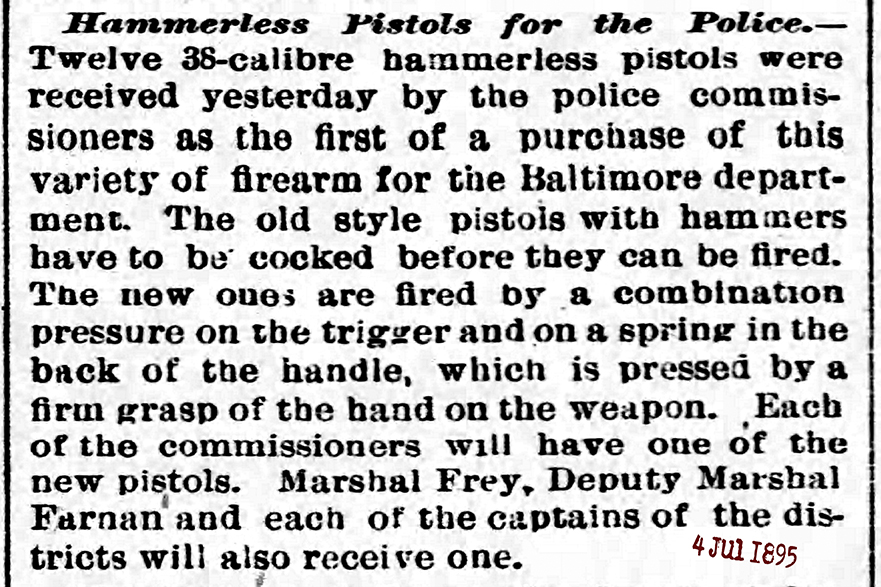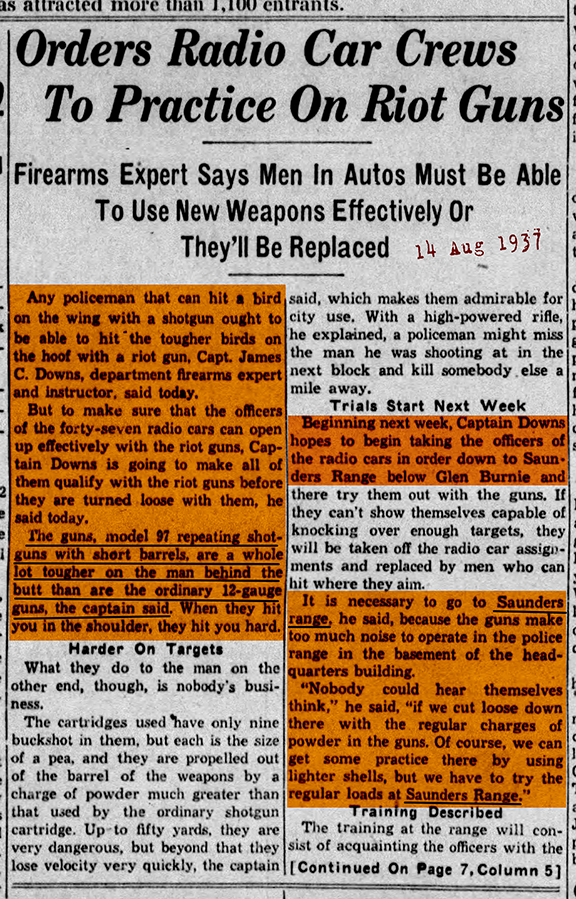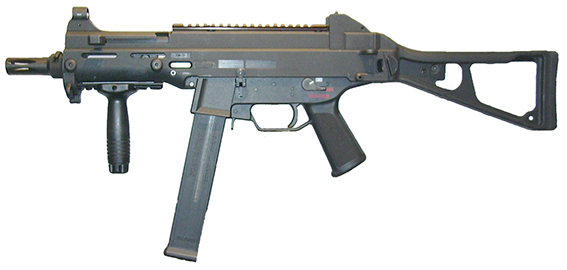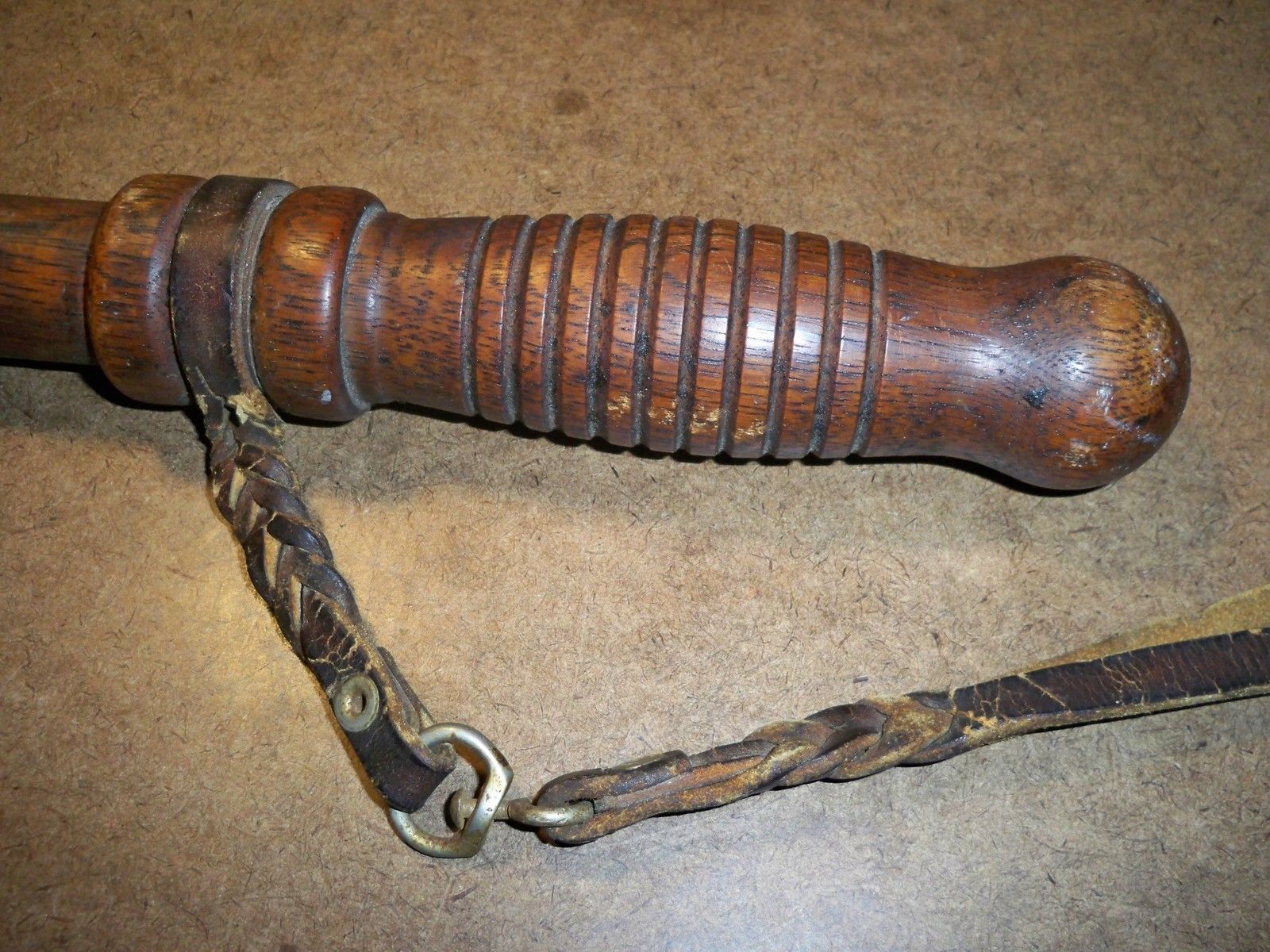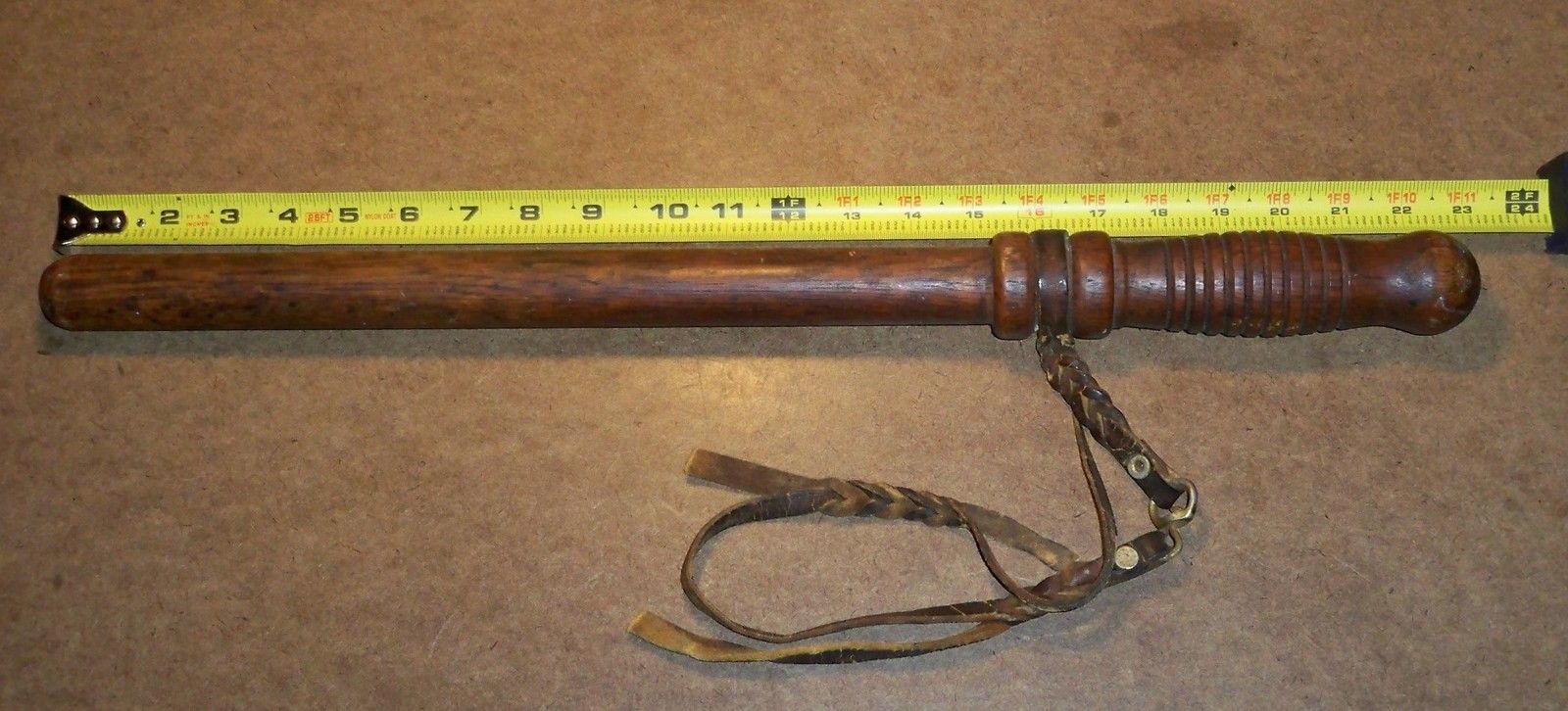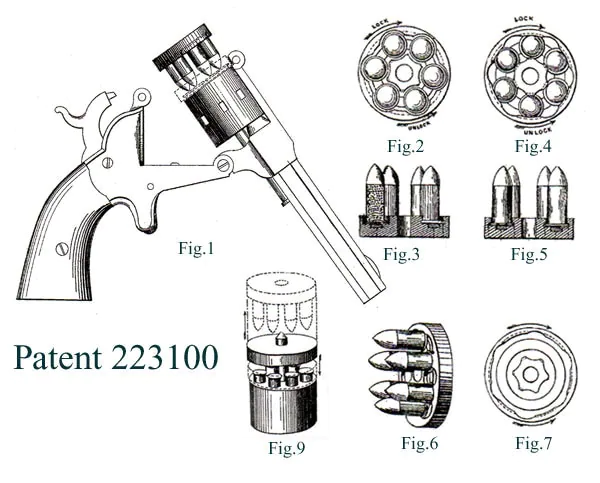Weapons
Baltimore Police Weapons
Pistols - Slap Jack - Espantoon - CS Mace - Pepper Spray
We are hoping to provide as much info, and as many photos as we can on/of the weapons, and means of restraint used by the members of the Baltimore Police Department over the years from 1729 to present day. Weapons and means of restraint to include, Pistols, Shot Guns, Rifles, Black-Jacks, Slap-Jacks, Sap-Gloves, Espantoon, CS-Mace, Pepper-Spray, Iron-Claw, Come-Along, Etc
![]()
Excerpts from - Proceeding of City Council 11 Dec 1856
(During this December 11th session in 1856) Mr. Boyd moved to strike out all of the section providing for arming the police with revolvers and other suitable weapons and placing muskets at the station-houses. Mr. Boyd said the cost of arming the police with revolvers would alone amount to $516l; that there were men in the police not fitted to trust with arms, and if the amendment was not adopted he feared he should be compelled to vote it was necessary to arm the police, as long as rowdies were armed with revolvers and other weapons. In New York and Philadelphia where there is a penalty for carrying concealed weapons, the police are armed by the city authorities. The muskets at the stations houses were to be kept there under the charge of the Mayor, to be used only in case of riot, where such arms were necessary to compete with armed mobs Mr. Boyd replied that only a few weeks since one of the police bad drawn his revolver at Carroll Hall on one of the night police - he reiterated that there were men not fit to be trusted with such arms. The time was when twenty-six men kept this city quiet and in good order without being armed. As to giving the police muskets, we might as well have a standing army. If muskets are necessary at any time, the military are always ready to obey any call of the Mayor. Mr. Pinkney again urged that it was necessary to arm the police - you must arm them to have any effect at all. If the military were called out at the present state of feeling in the public mind, instead of preventing or suppressing a riot, it would lead to one of the bloodiest riots on record. Mr. Howard opposed the amendment - he believed that it was necessary to arm the police in order to protect the citizens - to put down the riots that had so often of late violated the law and shot down peaceable persons. We may have seen outrages heretofore, but we have not seen orderly citizens shot down at their own doors - men driven from the polls when only seeking their right of exercising the elective franchise – polls obstructed and men leading on armed mobs with apparent impunity - Mr. Boyd was willing to judge the present by the past - If we are to have no better men on the police than for time past, he was not willing to place arms in their hands. If the police are armed, no man is safe in this community. The question being taken on Mr. Boyd's proposed amendment, it was rejected by yeas 3, (Messrs. Boyd, Tidy, and Carroll,) and nays 16. Mr. Nalls moved to strike out that portion of the ordinance placing muskets at the station houses rejected by yeas 6, (Messrs Daiger, Boyd, Green, Tidy, Carroll and Nalls,) and nays 13. Section 8 was reconsidered, on motion of Mr. Handy, who moved to amend it by making our police officers be confirmed/sworn by the city council, as other city officers are; which was adopted with but one dissenting voice.
During the times the city was nearly taken over by several gangs involved in politics, they would travel the various wards making it nearly impossible for honest voters to vote. As such elections were not fair, the same people won every time. I wouldn't be surprised to hear Mr. Boyd was benefiting more by having the Know Nothings, Plug Uglies, Bloody Tubs, Etc. ruling the city with an unarmed, or under armed police force, at the time police carried their own weapons, usually single shot pistols, or some other small pocket pistol, ill-equipped to fight these gangs. We lost several officers at the times. Still arming police, wasn't as much to help, or protect the police, so much as it was to allow politicians to receive fair votes. It may also be worth reminding readers of the Know-Nothing Riot of 1856, in which some of the worst rioting of the Know-Nothing era in the United States, had occurred in Baltimore. It was the fall of 1856, street tensions had escalated sharply over the preceding six-dozen years as neighborhood gangs, most of them operating out of local firehouses, became increasingly involved in party politics. Know-Nothing candidate Thomas Swann was elected Mayor of Baltimore in 1856 amidst violence and a heavily disputed ballot. Police Commissioner Kane was also involved in this, and in fact testified in open court for the defense in a trial against a Know-Nothing that was charged with killing one of Kane’s Officers, Kane was more dedicated to his party than he was his own men. Based on what these gangs were doing, it is obvious what some politicians wouldn’t want to fight it. The point being, City Council wasn't interested in Officer Safety, or even Public Safety at the time, as much as they were in getting voters to the polls.

Courtesy Robert Lee Keene
Baltimore's Pistol Range
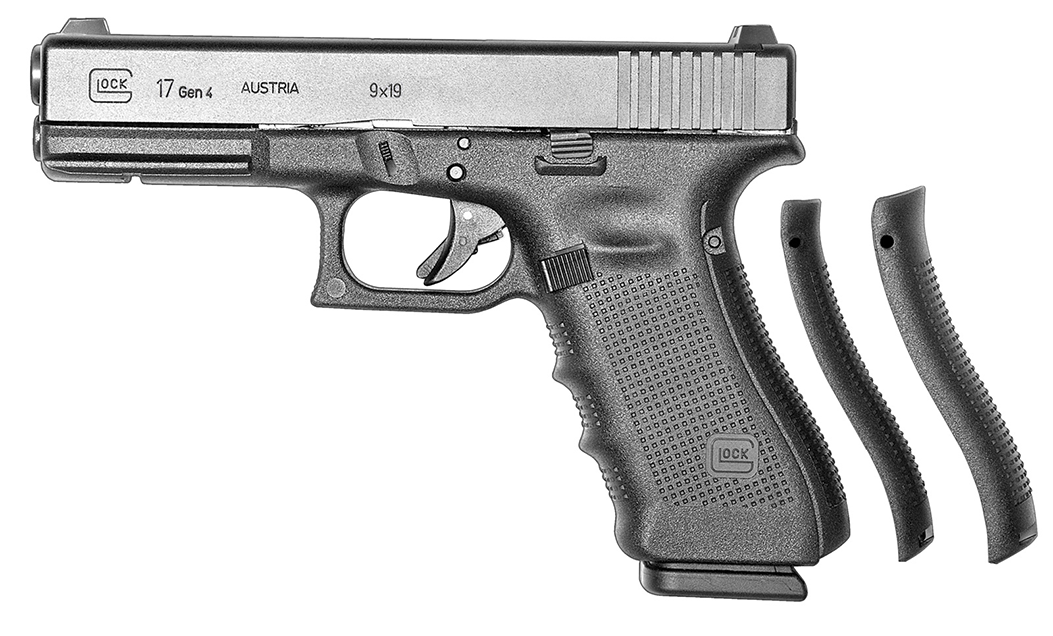
The primary service weapon today is the Glock 22 .40 caliber pistol. Officers are also provided with a Monadnock expandable straight baton, Taser X26, and pepper spray. Remington 870 shotguns are available as well as a less lethal model of the 870. In heavy situations, SWAT officers may employ the use of the G36, which fires the 5.56 NATO round, the H&K UMP40, and M4 variants.
The Espantoon is a type of wooden police baton that is distinct to the city of Baltimore and has been in use for generations. It is an ornate wood straight baton equipped with a swiveled leather strap with which it can be twirled. Between 1994 and 2000, the Espantoon was banned in favor of the Koga stick due to police commissioner Thomas Frazier's perception that its twirling intimidated the citizenry. In 2000, Edward T. Norris assumed the office of Police Commissioner and lifted the ban on the Espantoon, although he did not mandate its use or resume issuing the weapon. The move was made as part of a general effort to boost morale and instill a more aggressive approach to policing in Baltimore. Norris stated, "When I found out what they meant to the rank and file, I said, 'Bring them back.' ... It is a tremendous part of the history of this Police Department." While the move did not make the Espantoon an issued item by the department as it once was, it remains to this day an optional piece of carrying equipment.
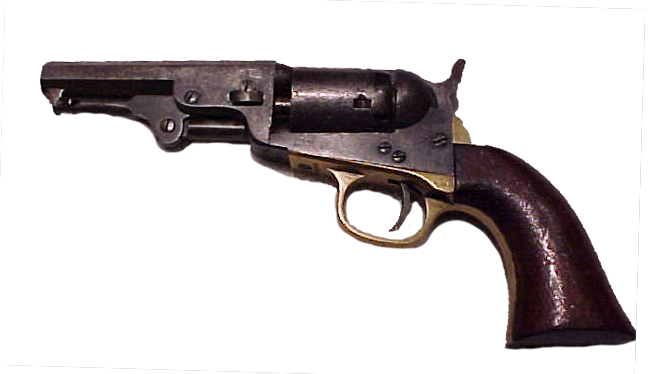
1857-1876 - Colt Caplock .31 Cal. Pocket Model revolver.![]()
On 3 July 1895, one dozen Smith & Wesson .38 Cal Hammerless revolvers were purchased by the Baltimore Police Department, These were double action, and as things have always gone they issued these to the bosses first. Good thing, the brass could remained safe behind their desks, while the men in the field continued to carry the single action crap that also as things have always gone in Baltimore, the criminals had the better guns, and the police began playing a game of catch up It would be 1990 before The Baltimore Police would stop carrying the old wheel-gun, and finally get a 9mm semi-automatic pistol.
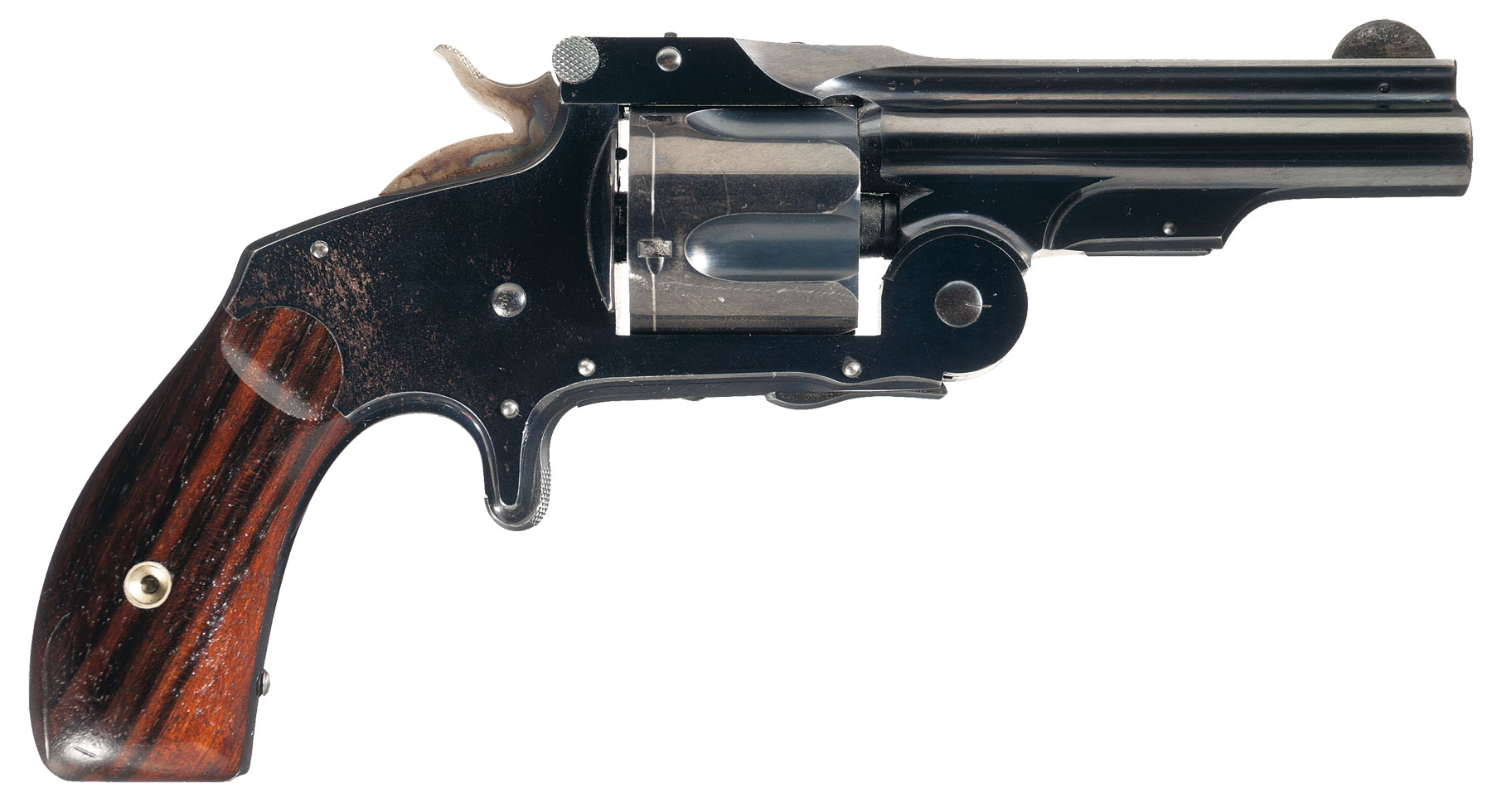
1876-1917 - S&W .38 Single Action First Model (4”) revolver.
![]()
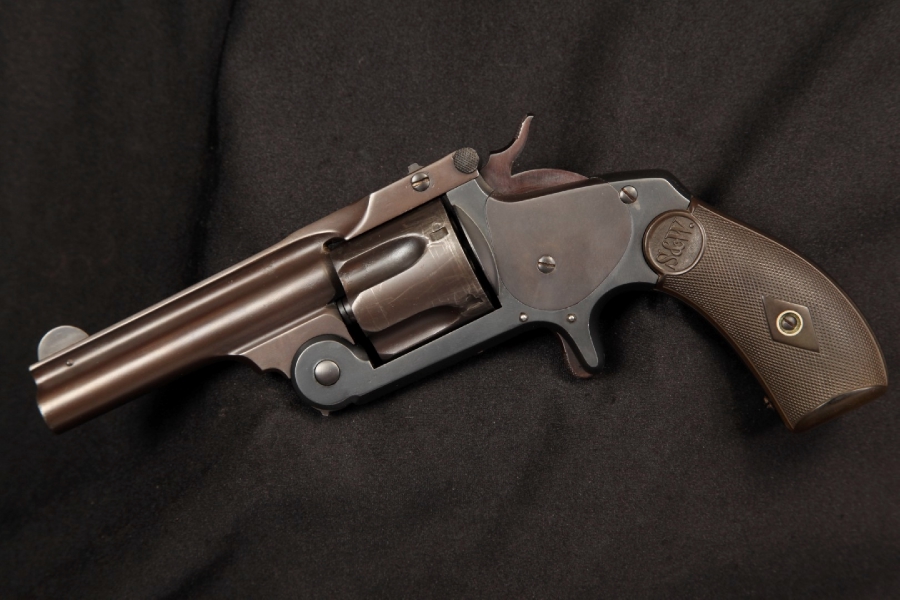
1916-1924 - S&W .38 Single Action Third Model (4”) revolver.![]()
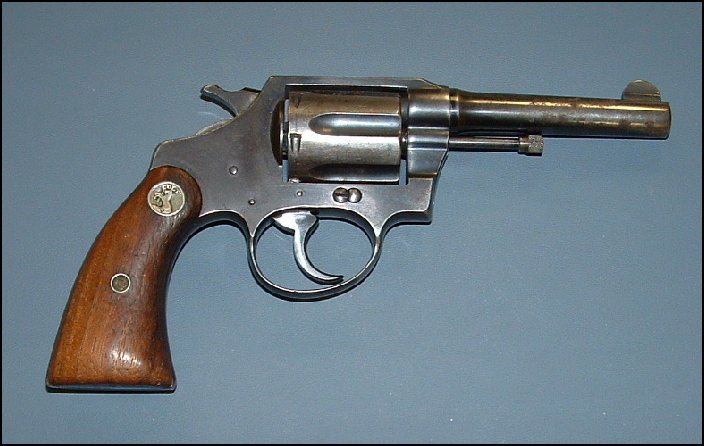
1922-1970 - Colt .38 Police Positive Special (4”) revolver.![]()
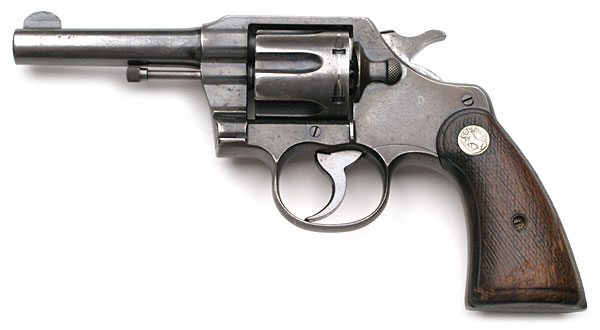
195?-197? - Colt .38 Official Police (4”) revolver.![]()

195?-197? - Colt .38 Detective Special (2”) revolver.![]()
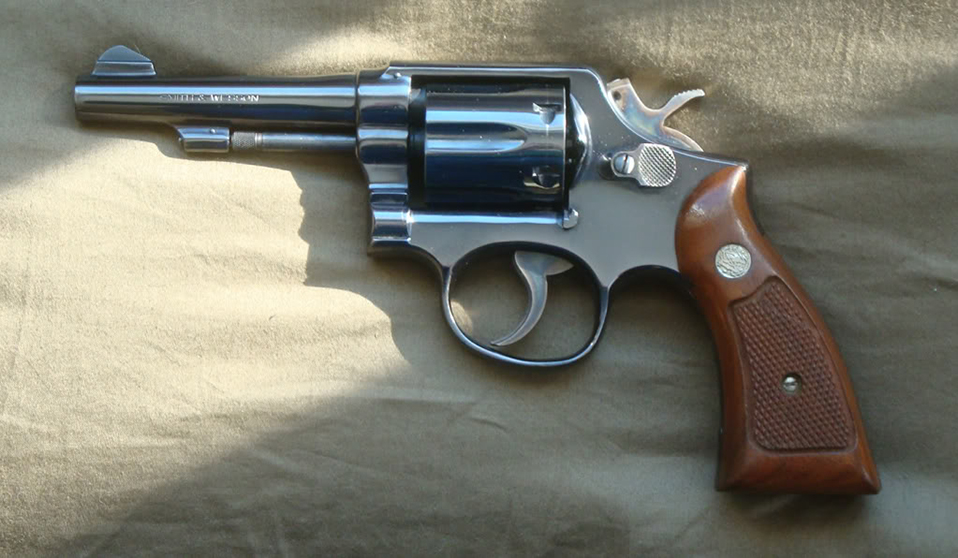
197?-1990 - S&W Model 10 Military & Police (4”)
Our Issued Model 10s had the heavy barrle as pictured below on the Model 64
More important than the Barrles issued were the grips, our guns were purchased
from Smith and Wesson with the oversized, "Target Grips." Photos will be added later![]()
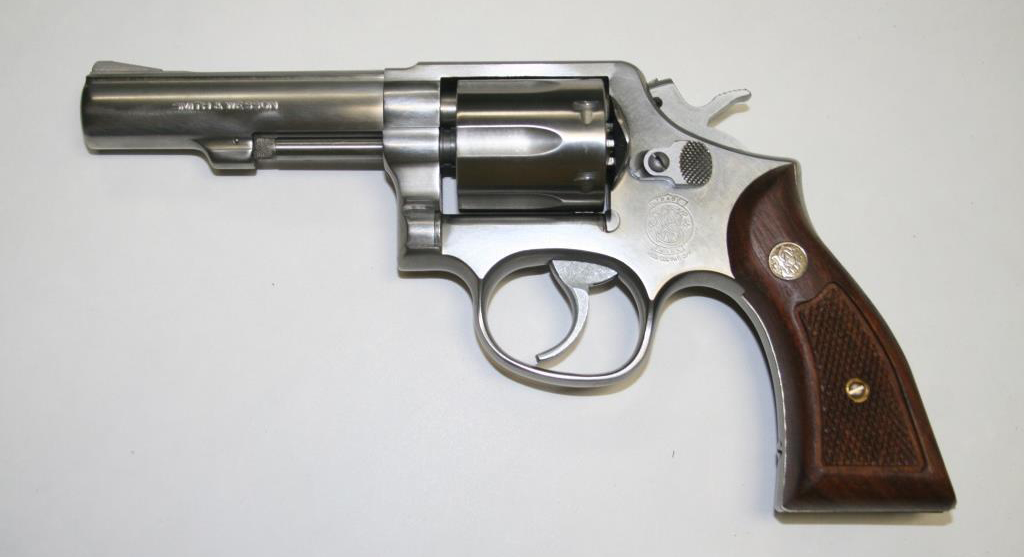
197?-1990 - S&W Model 64HB Military & Police (4”) Revolver.
The model 64 and model 10 are essentially the same gun. The model 10 is a blued, steel, the model 64 is made of stainless steel, both guns are sold with the smaller "magna" grips. The magna grips are the grips that just fit the frame. These guns are typically numbered in one place, and that is on the base of the pistols butt on the pistol's frame. Baltimore specifically ordered the oversize wooden grips. This was better for our shooters, but caused and issue where the serial number on the butt was covered. With this, in order to see the serial numbers, we had to remove the grips. To solve this problem, the BPD had to request a special order from Smith and Wesson, and that was in addition to the number on the butt, there would be a second serial number stamped on the gun that could be seen without taking the grips off. To do this, the put that second number on the frame under the Yoke Assembly.
Now this is an absolute 100% true story. This was going on while I was on the job. A lot of guys had the ammo webbing either built into their duty belt, or they had the slide on ammo webbing, some of these webbings held 6 rounds, others held 12 rounds. What a lot of officers were doing was taking issued ammo to a player to have them silver plated. Other officers that had been involved in a line of duty shooting were cutting notches in their grips. Sometimes on the street if they were trying to show some neighborhood tough guy what a thought guy the officer was, he'd use his thumbnail to "flick" at the notch or notches.
Word got back to old Donald D Pomerleau and he was not happy. He said the Department had paid extra for those oversize grips and he didn't like anyone messing them up. Word went out to all the Districts and down to all the Sergeants - "Check your guys guns. Anyone that has "notches" on their grips was to report to the range for replacements." No names were ever recorded. Those were the days. We have several of the silver plated .38 cal. rounds, I think there are only 5 of the Long Ranger rounds in there, we are not sure if the officer, carried a five shot revolver and used them in the webbing of a shoulder holster on his belt, or what the deal was, he may also have had a 6 shot but gave a round to a kid on his post. We will try to grab the rounds and webbing we have and add a picture to the site soon. The information pertaining to the serial numbers comes to us from a former Baltimore Police Officer named Gary Provenzano![]()
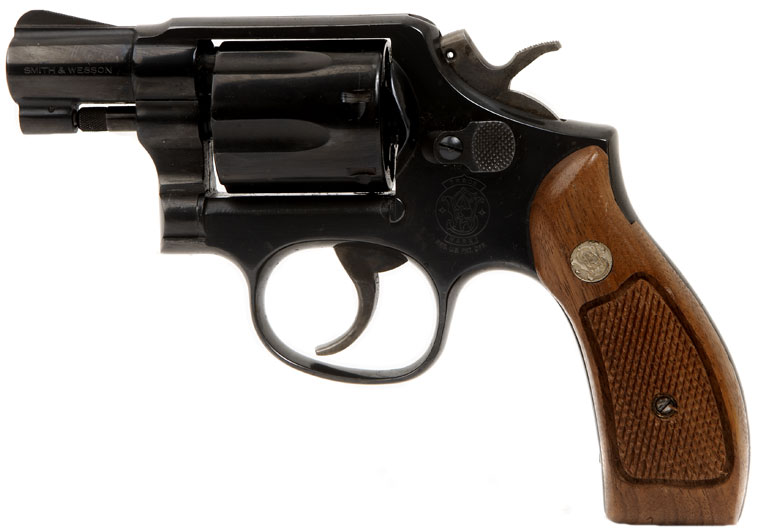
197?-1990 - S&W Model 10 Military & Police (2”) Revolver.![]()
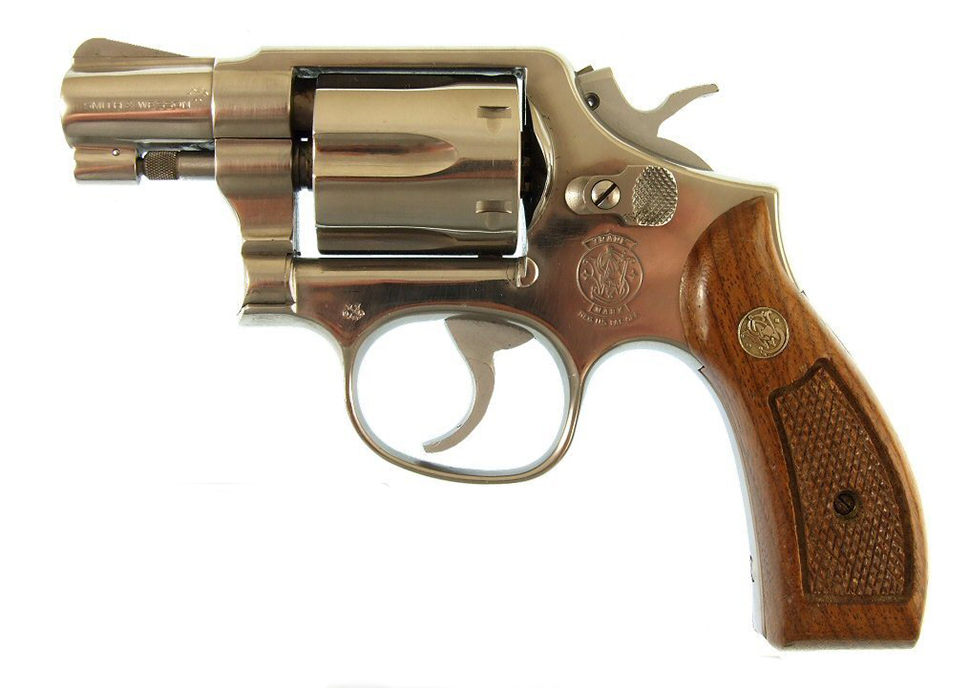 197?-1990 - S&W Model 64 Military & Police (2”) Revolver.
197?-1990 - S&W Model 64 Military & Police (2”) Revolver.![]()
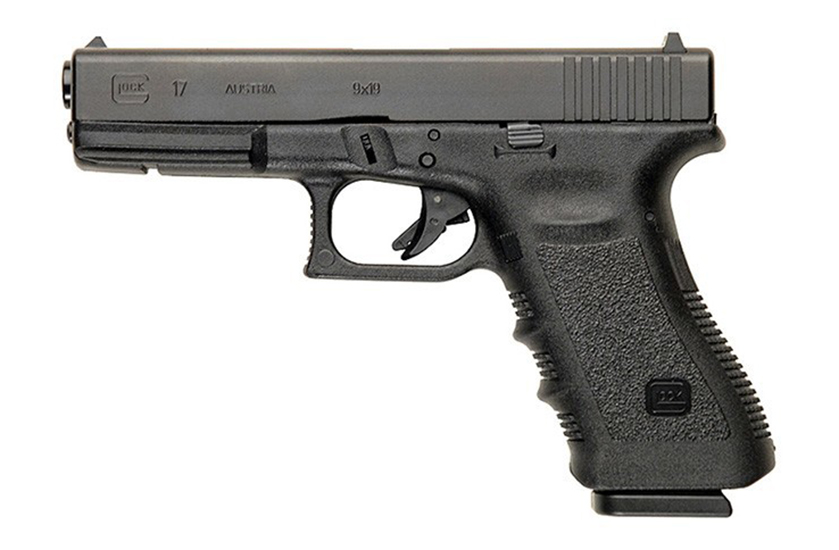
1990-2001 - Glock 17 - 9mm pistol.![]()

1922-1931 - Auto-Ordnance Model 1921 Thompson sub-machine gun.
Click HERE or on the above article to see full size article
![]()

1931-19?? - Colt R80 Monitor automatic rifle.![]()

19??-19?? Winchester Model 670 bolt-action rifle.![]()
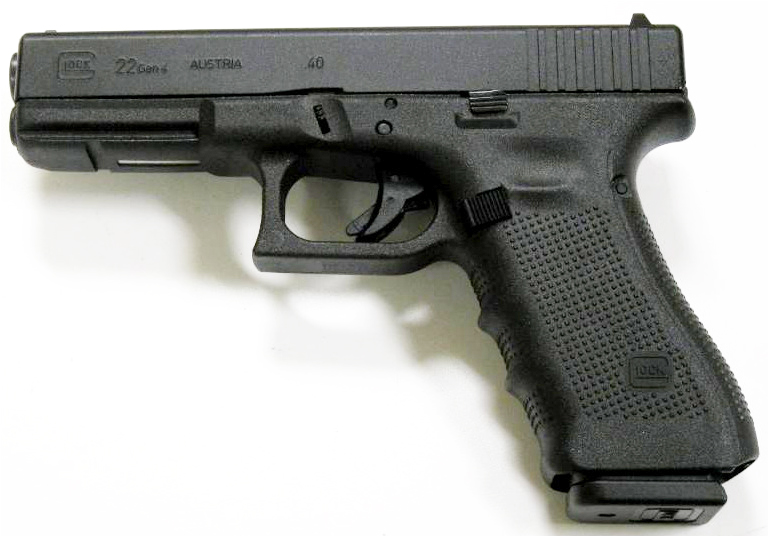
2001 - Glock 22 - 40 cal. pistol.![]()

Winchester Model 1897
The Model 1897 was a superior slide-action exposed hammer shotgun that was specifically designed for the new smokeless powder. Winchester manufactured just shy of one million Model 1897 shotguns, with the production taking place from July 1897 to September 1957. The Model 1897 was an improved redesign of the older Model 1893. Serial numbers were a continuation of the Model 1893 and began in the 34150 range, and continued through 1024701.
The Model 1897 was originally offered in solid frame 12 gauge only with a 2 ¾ chamber until April of 1898 when the Take Down was introduced. The new 16 gauge with a 2 9/16” chamber was introduced in 1899, Take Down only.
The Model 1897 was offered in a variety of grades: standard Field; Fancy; Standard Trap; Special Trap; Pigeon; Tournament; Brush; Riot and Trench Gun. The 20” barrel Riot and Trench Guns were especially desirable for Military and Law enforcement use. The Law enforcement Riot and Trench Guns may have police or prison unit markings. The WW II military Riot and Trench guns will have “U.S” and flaming ordnance bomb markings. Trench guns differed from Riot guns in that they have a ventilated heat shield and a bayonet stud attachment. All Trench Guns and the military Riot Guns were equipped with sling swivels. The WW I Trench and Riot Guns were made in solid frame only, then for WW II, they were all Take Downs.
Shotguns were first put in radio patrol cars in 1937 the shotgun used at the time was the Winchester 1897. They only had 47 radio cars citywide at the time, training for the shotgun was done at Saunders Range in Glen Burnie. If officers couldn't qualify, they would be sent back to foot patrol and someone else would be given a chance. Training for qualification began on 21 Aug 1937
To read the above article in full size click HERE or on the article
To read the above article in full size click HERE or on the article.
Saunders Range, named for Adjutant General of the Maryland National Guard, John S. Saunders, opened in 1904 on the property now known as Harundale. It was established for the training of army, navy and guard personnel in shooting and marksmanship. Men were assigned by company to spend two or three days at the site gaining proficiency with rifles and revolvers, aiming at targets set 200, 400, 800 and 1000 yards away. The training season ran from May 1 to about mid-August after which the site closed for the winter.
Practice began at 8:15 a.m. and ended at 6:00 p.m. with a one-hour break for lunch. Men lived in tents on the ground with few amenities at first. The year after the range was established, a canteen was added with a “No Intoxicants” policy strictly enforced. Emil E. Vanous and his brother, William, local residents were awarded the contract to run the establishment. In the following years an administration building was erected, and a sewage system was installed in 1910.
The site was ideally located in open country with sandy soil providing good drainage and a plentiful artesian water supply. It was close to the B&A Short Line Railroad which provided transportation and to Furnace Branch Creek which provided recreation for the men. Even at the time, “open country” was a debatable term. Mr. Osborn S. Pumphrey who owned a large farm in Marley, complained vociferously that bullets from the range were striking his house and he could not hire laborers for the fields since they feared being shot. Changes to target siting seems to have remedied the situation.
While the nearby railroad offered easy transportation to both Annapolis and Baltimore, few passes were given to the soldiers for fear of their bringing back “diseases contracted in the city.” Instead, evening entertainments were supplied within the camp. Shows with singing, music and “moving pictures” were offered along with boxing matches between companies. Shooting competitions were also held with medals and cups awarded to the best marksman.
In 1915, as the World War loomed, mobilization of civilians began. Classes of recruits were sent to Saunders Range for an introduction to military regulations, physical drills and shooting practice.
Saunders Range closed in 1926 and the Maryland National Guard put the property up for sale. In 1939, a proposal to build a “Negro housing development” on the site was met by spirited local opposition and soon abandoned. Finally, in 1946, the property was acquired by Byrne Communities, Inc. and in 1947 ads began to appear in local newspapers offering homes for sale in the new development of Harundale.
Information on Saunders Range came to us from Ann Arrundell County Historical Society
![]()
 Federal Gas Riot Gun
Federal Gas Riot Gun
Description:
1.5 cal Federal Laboratories Inc. Pittsburgh, PA. Gun, a single shot has, flare, rubber ball or Buckshot with adapter. Steel barrel receiver with wood furniture. 1-1/2” bore; barrel is 12”,27-1/2” overall. Blue finish on all meta, varnish on all wood. Plastic butt plate. Break open action latch for opening, includes a sight set for 50 yards.
Considered to be a very early model; 4 types were produced. Used by police and prisons for crowd control. Mfg 1933. When fired for training, gas round went through both sides of house! Not an NFA controlled item unless you have buckshot adapter. No FFL or C&R required.
The Winchester Model 1897 became the most popular exposed-hammer, slide-action shotgun in history. Special features include fancy checkered walnut stocks, Damascus barrels, and engraving. According to a 1916 catalog, the plain-finish example sold for $25, while an engraved receiver with checkered and finer wood sold for $100.
Original Winchester factory records are available for this model from the Cody Firearms Museum in Cody, Wyoming, from serial number 1 thru 377999. Polishing Room serialization records are available for all serial numbers. In Baltimore these guns were altered when they cut the barrel down the 20" barrel so they could maneuver in tight spaces, like Baltimore Row-home hallways, and staircases.

18 Sep 1956
The start of the agency's Riot Squad, and introduction of the Federal Gas Riot Gun
![]()

1964 - Remington Model 870 Police Magnum pump-action shotgun.
On 24 March 1964, the department announced the addition of 18 New Repeater Shotguns. Chief Inspector George Murphy reported that these guns were issued to 18 Police Radio-Cars, two in each of the nine districts. The Remington 12-gauge Pump Action Shotguns were issued primarily to the two cars in each of the nine districts that were designated as two-man cars. There were additional shotguns of this make and model purchased Some went into the armory, while others were assigned to the Department's Detective Bureau.
It is hoped that with the addition of these new guns we will have a further deterrent in the combat against violent crimes. While speaking of the department's former shotgun, a Winchester 12-gauge, "If they do not deter an attack on our officers, they will undoubtedly not defend an attack on our citizens." In 1964 Chief Inspector George Murphy said, of these new Remington shotguns, "They will pretty definitely, be effective."
The five-shot repeater has an "effective" range of 45 to 50 yards," said Serge. James Freeman, the department's firearms instructor. "Over 50 yards the nine .38 cal. Buckshot pellets fired from each shell will spread out to about four feet broad." Serge. Freeman said as he continued, by saying, "Effective Means Fatal!" An answer to what his Chief Inspector may have meant earlier when he said, "They will pretty definitely, be effective." In short, The Sergeant was saying, "These weapons are pretty brutal." He feels the weapon's killing power is about 10 times that of the .38 Cal. revolvers being carried by the officers patrolling our streets in the 1960s. The Chief Inspector said the shotguns have been issued for the use mostly in combating bank robberies, and commercial as well as residential, and highway or street robberies.
Two Baltimore City Police Officers, Francis R. Stransky and
Claude J. Profili had been killed up to this point in 1964. However, there would be three more Baltimore Police Officers killed before the year ended, they were Officers, Walter Patrick Matthys, Teddy L. Bafford, and Sergeant Jack Lee Cooper. Another of our officers was seriously injured in 1964 after being shot as he sought to capture a hold-up suspect.
If a criminal was thinking of bringing harm to a business owner, or a pedestrian walking down the street in Baltimore, and one of our officers came upon the scene with one of the new Remington pump-action Shotguns, we can assure you a reasonable and prudent man staring down the barrel of one of these weapons, it would stop them!" Inspector Murphy said at the time, "If they shoot at any of our officers, you can bet the officers will return fire."
Serge. Freeman said, "98 of the new guns have been purchased as replacements for the 1897- model Winchester Shotguns that were taken out of use in the late 1940s. Those old guns were basically modified hunting guns that we had the barrels machined down to 20 inches."
Each of the officers that will have access to these weapons will receive 12 hours of instruction to assure they were adequately indoctrinated and trained, in the use of this weapon." said Chief Inspector Murphy. Murphy was followed by Serge. Freeman who said, "During the Department's 12-hour course, officers are trained in the handling of the shotgun, the disassembly, reassembly, cleaning, and general maintenance of the shotgun. Following that, they are trained in, loading and unloading the shotgun. This is all before anyone would be taken to our range where they will first learn to hold, carry and aim, the loaded shotgun. But, they will not fire any of the weapons until they qualify with safely handling the weapon; to include breaking it down, cleaning it, and rebuilding the weapon. When they successfully qualify for this portion of the training, they move on.
Once an officer is completely trained in how to safely handle the weapon in public situations, whereas they prove their knowledge as to how the weapon is broken down, cleaned, oiled and reassembled within a timed examination. Once our officer satisfactorily meets the requirements of the first portion of this training, (Knowing the Weapon) they can move on.
The last parts of their training involve more than just aiming at a target, but knowing what's behind a target as we visualize a practicum in which we are confronted by an armed suspect [the target], and then using risk assessment of taking, or not taking the shot. Officers being reminded, "Not" taking the shot, can make an officer as liable for suit as taking the shot and hitting a bystander. If a suspect brings harm to someone and as officers, we fail to protect them. The Sergeant went on to say, all the training in the world is good, but it is pretty much up to a man's common sense." Serge. Freeman agreed with the Chief Inspectors assessment in that the shotguns will be effective in reducing, if not stopping certain crimes." - "A lot of people will throw down their weapons at the crime scene, or give themselves up rather than face down a shotgun." he, continued, "Criminals know what a shotgun can do to a person, and so they more often than not will do the smart and prudent thing!!!"
The issued 870 had 20" barrels, rifle sights and were equipped with leather slings. Every sector in every District had a 2 man "Shotgun Unit" that was also a regular Sector Car. The shotguns were kept in a wooden case/box in the trunk of the radio car. The original weapons issued to QRT, besides the standard Model 10, were Remington 870 Shotguns, Universal M1 .30 caliber carbines (which they thought would be ideal for penetration), M-16's (which were to be kept on semi-auto unless otherwise authorized by a "Superior Officer"), and a Winchester Model 70 bolt action sniper rifle in .243 caliber.
![]()

200? - Springfield M14 semiautomatic rifle.![]()
Baltimore City Police Department
1975 Quick Response Team (QRT) - 2006 Special Weapons And Tactics (SWAT)
QRT/SWAT in 1975 when they started working on forming the SWAT team, the team name SWAT was rejected, after serious consideration, QRT (Quick Response team) was chosen. It wouldn't be until 2006 that the Baltimore Police Department would accept the name change, and replace QRT with the name SWAT![]()

1990-2001 - Glock 17 - 9mm pistol.![]()
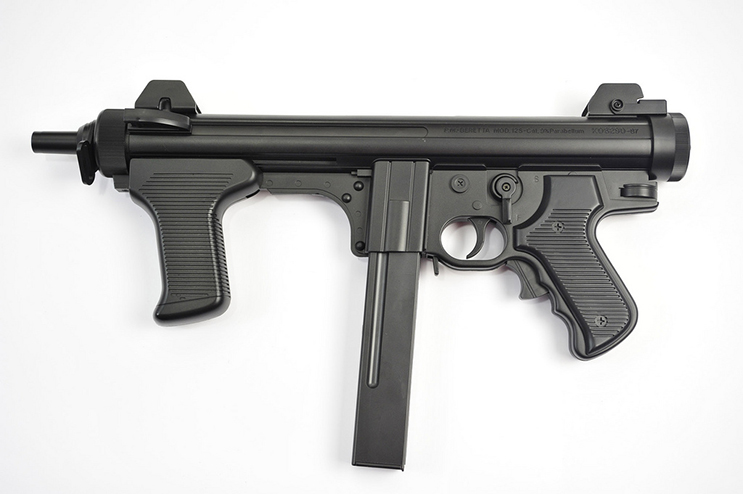
1986-???? - Beretta Mod 12S submachine gun.![]()
200? - (.40 S&W) H&K UMP sub-machine gun.![]()

200? - H&K G36K assault carbine.
![]()
 Baltimore City Police Baby Russian
Baltimore City Police Baby Russian
Man and Arms Magazine
Volume 1 - Number 5
September/October 1979
The Baltimore City Police Baby Russians
By Major Charles W. Pate
One can say with considerable confidence that the most widely known single-action Smith & Wesson used in police service is the “Nashville Police” American Model. Several factors combine to make the Nashville Police a highly sought-after collector’s item. The guns were all First Model Americans, which in itself makes them quite desirable. They had special order 6-inch barrels. There were only 32 ordered. And, last of all, they are distinctively marked on the grip backstrap.
Much less well known is a Smith & Wesson which also saw law enforcement service, a .38 single-action First Model, better known as the “Baby Russian.” While the model is in itself a very interesting one to study, the specimen illustrated here has additional significance and that it was one of an apparently small number used by the Baltimore City Police Department.
The Baby Russian (properly called open, .36 single-action First Model” or “Model Number Two First Model”) was the direct predecessor to .38 caliber revolver that became the standard for the world. During the early 1870’s there was growing demand for a modern, automatic injector revolver was stopping power but without the weight, size, and inconvenience of the .44 or .45 pistols. “Texas Jack” Omohundro wrote to Smith & Wesson inquiring as to the availability of a .38 caliber pistol using the Smith & Wesson .44 style action. He stated, “I have been requested by many friends to get them one but have been unable to find them in sale stores. Weight seems to be the objection to the larger.” Regardless of how he was convinced as to the demand for such a pistol, D. B. Wesson soon had one to fill the bill.
The Baby Russian was to be the first in a long line of revolvers which, perhaps more than any other, has served to make Smith & Wesson successful and famous. Interestingly enough, Mr. Wesson chose first to design the cartridge rather than the revolver: the .38 Smith & Wesson – a centerfire, reloadable cartridge which has an actual bullet diameter of .36 rather than .38. The revolver designed to use the new cartridge was essentially a scaled down version of the new model Russian – hence the term “Baby Russian” the most obvious difference between the two, other than size, is the spur trigger guard in place of the boat type with finger spur used on the larger pistol.
The Baby Russian was made for only a little over a year. It was first commercially available in March/April 1876 and was replaced by the .38 SA Second Model in July 1877. Serial numbers run from one to approximately 25,548. There are several variations of the revolver which, together with the relatively small number produce, enhance its collectors interest. There were two barrel lengths – 3 ¼” and 4”. Standard finish was nickel and only 6502 were produced in blue. Of the blue guns 6333 had wood grips; the remainder were finished with rubber, pearl, or ivory grips. Only the very early nickel guns had wood grips. Hard rubber grips were introduced with this model and were the standard grips for the nickel pistols. There are other variations, however they are of little significance except to the advanced Smith & Wesson collector.
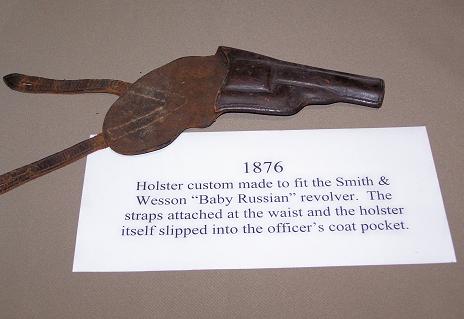
The Baby Russian and its immediate successor, the .38 SA Second Model, enjoyed considerable success. Between 1876 and 1891 a total of 133,803 of these guns were made. Also, during and after this period, the same .38 Smith & Wesson cartridge was being used in the .38 Smith & Wesson double-action and Safety Hammerless Models. However, the utility of the .38 SA Smith & Wesson was demonstrated not only by the number of guns sold but also by who was buying it.
Jacob Wagner, a Federal Revenue Agent, bought several for his fellow agents to supplement the Schofield’s with which they were armed. Max L. Gumpert a Military Taylor, requested price quotations for five dozen for resale to St. Louis Policeman. Without a doubt, many such men bought these guns for personal use as pocket pistols. While individual purchases were a common occurrence, the only group of .38 SA’s known to the author which show evidence of purchase by a police organization is the “Baltimore City Police.”
Over the past few years several of the Smith & Wesson Baby Russian revolvers with “Balto. City Police” engraved on their back straps have been noted, all in the Baltimore, Maryland, area. Six complete revolvers and parts of two others have been studied in detail. A close-up photo illustrates the most distinctive aspect of the revolvers are a number 6702. Revolvers 4746 – 5052 – and 5154 all have identical back strap markings. Unfortunately, frames of the other revolvers listed in the accompanying chart were not available for study.
Reportedly other styles of marking exist on Balto. City Police Baby Russians. Sgt. Bruce Green, and Unofficial Historian of the Baltimore Police Department, has observed three styles of markings: a script style of a priceless same size illustrated, the block style of the above gun, and a block style with smaller letters. All are engraved as opposed to being stamped, and all read the same “Balto. City Police,”. The illustrated markings are 1 3/8 inches long, “Balto. City Police,” and are centered on the backstrap.
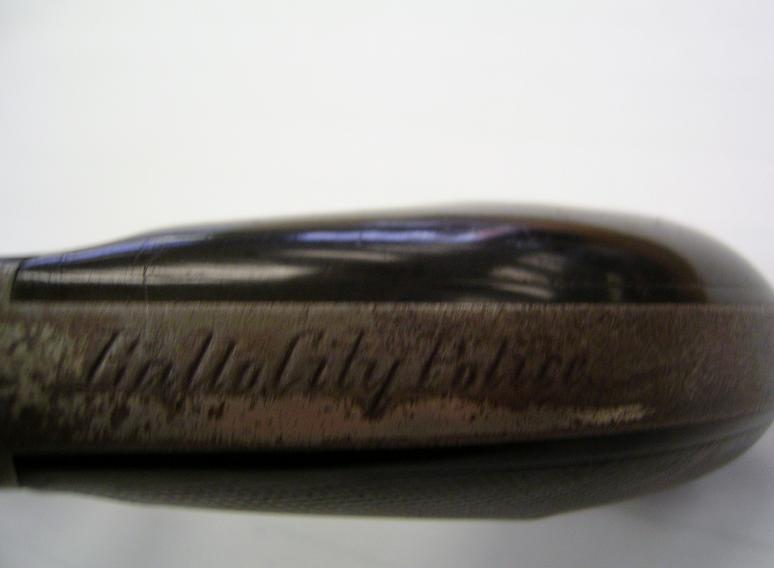
At this date little or no documentary evidence links these guns to the Baltimore Police Department. Sgt. Greene has done considerable research of existing records of both the Police Department and appropriate city offices. He reports that few records now exist, and those that do lack organization and proper care. The only documents found so far which probably concerned these revolvers refer to the “.38 caliber” weapons in use. No other .38 caliber weapons of this vintage are known to exist with similar markings. While they may be the case, the lack of hard documentary evidence is frustrating. It appears that we are not as fortunate as the researchers of the Nashville Police American Model, since they found significant references to the purchase of those firearms.
The Baltimore area people seem unconcerned about documentary evidence. To them it is a commonly accepted “fact” that these guns were used by the Baltimore Police Department. Several of the recent or current owners of the known specimens are active or retired members of that force. Additionally, examples of a peculiar holster are known to exist which was used with the Baby Russian. This also reportedly was secured by uniform buttons instead of belt or straps.
Sgt. Greene estimates the period of use for these revolvers was between 1876 and 1917. Prior to 1876, and perhaps for some time afterward, Percussion Colt Pocket Model were in use. Several such revolvers are in Baltimore area collections and have back strap markings the same as or similar to those on the Baby Russian. In approximate 1917 the Baltimore Police Department switched to the Smith & Wesson Perfected Model. Two examples of this model, again marked in a similar manner – were manufactured in 1917. The Baby Russians period of use is a matter of speculation, with only the shipping dates of marked weapons and a very limited documentation providing evidence upon which assumptions can be based. While this is true, the weapons themselves to provide some very convincing evidence that the guns were at least used by that organization.
The accompanying chart depicts the common characteristics of the guns. Note that all were shipped to the same dealer at about the end of July 1876, all undoubtably part of the same order. The dealer, Trimble and Kleibacker, was a gunsmith firm located at 200 West Baltimore St. in Baltimore. This partnership was formed after a previous partnership [1860 to 1876] between Thomas Poultney and David B. Trimble dissolved. The earlier partnership was apparently successful considering its duration and the fact that the Federal Government purchased 30,362 Smith carbines from the firm during the Civil War. Trimble Association with C. B. Kleibacker lasted until 1880, after which the firm is listed only under the Trimble name.
The revolvers all appear to be the same configuration: 4” barrel, hard rubber grip, nickel finish. At least three of the listed guns are re-nickeled and suitable characteristics of non-factory refinishing. One gun is not obviously refinished but has nickel plating in the engraving, an indication that the weapon was nickeled after the engraving was done. The other guns which appeared to have original finish have no plating in the engraving. Most probably the markings were added after the guns left the factory.
In summary, the evidence, while somewhat circumstantial, is consistent an extensive. We have what is probably a satisfactorily significant number of marked examples (considering age and typical survival rate, the modest number of revolvers made with this exact configuration, and a reasonable geographic distribution of all those that were made in this configuration.) All the marked guns, for which serial numbers information exists, were shipped to the same dealer (in Baltimore) on or about the same date (suggesting a single quarter.) The dealer (or at least the Trimble half of it) was an established firm – the type from which a Police Department might buy guns. The guns have commonality of marking and share this common feature with other guns purported to have seen service with the police department. All the revolvers have seen extensive use and the refinished guns so that considerable use occurred after the refinish work. This would be consistent with a long period of use by the police. The numbered parts of the given revolvers may be present on one or more revolver from the same group (a common occurrence with military or police guns.) The markings are obsolete very old as evidenced by the presence of nickel plating in the engraving all well-used re-plated revolvers. And, lastly, all the known examples have come from the Baltimore area. This would also support the estimated long period of police use. Almost all of the Balto. City Police Baby Russians have been or are in Baltimore police officer’s collections. They have been, until now, virtually unknown or ignored by other collectors – even Smith & Wesson collectors.
While the evidence seems convincing – that the Baltimore Police Department did, in fact, by and use these revolvers – exactly how many did they buy? Were there other variations? How many still exist? Sgt. Greene states that he has seen a total of perhaps 10 – 15 of these revolvers. Reportedly the revolvers with the smaller block letters are from a considerably higher serial number range. However, the author has not yet been able to see any of these revolvers nor has he any data other than what is presented here. Any further information would be greatly appreciated by is website.
Note: In 1893, one Mr. William de Courcy Prideaux, a subject of Queen Victoria, patented a device he referred to as a ‘cartridge-packet holder’. This device was a circular disc through which 12 spring-steel fingers protruded in six pairs. Each pair held one .455 caliber round for the British Webley style revolver. A later 1914 improved design added a bridge-like handle to the rear of the plate. We know this device as the Speedloader -
Click HERE for more on the Speedloader
The Smith & Wesson Model 2
The Smith & Wesson Model 2, also referred to as the Smith & Wesson .38 Single Action, was a .38 caliber revolver produced in both single and double action by Smith & Wesson. The manufacturer's first of that caliber, its 5-shot cylinder was chambered in .38 S&W. The single-action was produced in three varieties from 1876 through 1911, with total production exceeding 223,000 units: the double-action in three variants from 1880 to 1913, with total sales somewhat under one-million guns.
The Model 2 fired a black powder cartridge. It was a "top-break" weapon, with the barrel release catch located on the top of the frame, just in front of the hammer. It was a larger caliber version of the third model of the Smith & Wesson Model 1 1/2.
Single Action - In 1876, Smith & Wesson Model 2 debuted in a single-action format, meaning the hammer had to be cocked manually to set the trigger in order to fire the revolver. These revolvers fired black powder cartridges and were available in nickel or blued finishes.
1st Model - The first model of the .38 Single Action can be identified by its smooth barrel (lacking fluting), and the long extractor shroud similar to the Smith & Wesson Model 3 Russian pistol, which lent it the nickname "Baby Russian". It had a spur trigger and lacked a trigger guard. Models were available in blued or nickel-plated finishes, and the majority were produced with 3+1⁄2-inch or 4-inch barrels, although barrels as long as 7 inches were sold.
Serial numbers range from 1 through to 25,548 between 1876 and 1877. This pistol was used by the Baltimore Police Department from 1876 to 1917 and such revolvers are marked "City of Baltimore".
2nd Model - The second model of the 38 Single Action used a shorter and more efficient ejection and extraction system and lacked the shroud of the 1st model. It was produced in blued steel and nickel-plated versions, with most models having a 3+1⁄2-inch or 4+1⁄2-inch barrel. Rare versions had barrels of 6, 8 and 10 inches in length.
These revolvers had a spur trigger, lacked a trigger guard and were serial numbered consecutively from 1 through 108,255. at least one second model was produced with a 5 in barrel, with last three numbers of SN "007".
3rd Model - The third model of the 38 Single Action was made from 1891 to 1911 and is often known as the 1891 Model, Model 01 or the Model of 91 as the latter is stamped on the top of the barrel. This version used a standard trigger and a trigger guard, but 2000 of these revolvers were made for the Mexican government with the spur trigger and no guard and are referred to as the "Mexican Model".
![]()
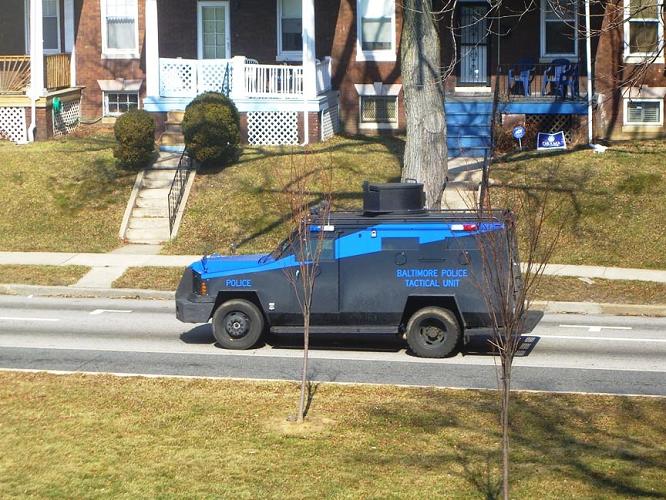
Uses the Lenco Bear-Cat 4×4 armored car.
![]()
The espantoon is a wooden police baton equipped with a long leather strap for twirling. It originated, and is still strongly associated, with the Baltimore Police Department in the city of Baltimore, Maryland. The term is considered distinctly Baltimorean. The word itself derives from that of a pole weapon, a spontoon, which was carried by infantry officers of the British Army during the Revolutionary period. Since the espantoon has been considered a symbol of the "policeman's office and dignity". Before the advent of wireless communications, the espantoon was reportedly used by Baltimore policemen to call for assistance where its user would bang it on the curb or a drainpipe. In 1994, Thomas C. Frazier took over as Baltimore's police commissioner and banned the espantoon. Frazier, a Californian, believed that the device, and the policemen's twirling of it, was intimidating to the civilian populace. He attempted to replace it with another weapon, the Koga. Many officers, however, felt that the Koga was cumbersome, difficult to master, and even more dangerous than the espantoon. In 2000, Edward T. Norris assumed the office of Police Commissioner and lifted the ban on the espantoon, although he did not mandate its use. The move was made as part of a general effort to boost morale and install a more aggressive approach to policing in Baltimore. Norris stated, "When I found out what they meant to the rank and file, I said, 'Bring them back.' ... It is a tremendous part of the history of this Police Department."
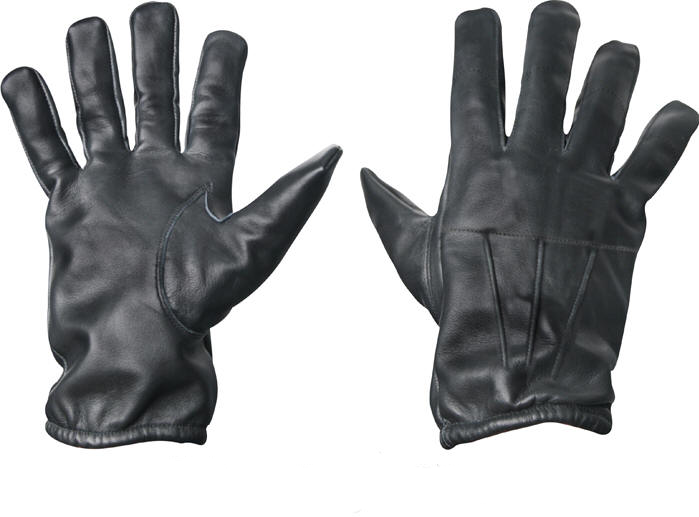
Sap Gloves - Weighted-knuckle gloves, also called sap gloves, are a type of weapon used in hand to hand combat. They consist of a pair of ordinary looking gloves usually made of leather or a synthetic material, with powdered lead or steel sewn into a special pouch covering the knuckles, and often the backs of the fingers and the back of the hand. In some designs, this distinctive feature is obvious, while in others it is almost completely indistinguishable from an ordinary glove, allowing the gloves to be worn in plain sight without suspicion. They are primarily used by security guards, and by bouncers and other security professionals where physical combat is expected. The purpose of these gloves in combat is both offensive and defensive. Offensively, the weight of the metal powder adds mass and therefore kinetic energy to punches, backhands and other hand strikes. The weighting also distributes the impact in a manner similar to a blackjack, transferring concussive force in the case of a head-strike to cause a knockout. This is the opposite of brass knuckles, which are designed to concentrate the force of a blow in a smaller area to cause more tissue damage. However, the primary aim of the gloves is actually defensive. Normally, punches with the unprotected hand against an opponent’s head or face will painfully injure the hand in the process, and strikes to the mouth can often result in severe lacerations from the opponent’s teeth. The layer of powdered metal serves to protect the hand against these injuries, without compromising the effectiveness of the strike. Properly executed, a person wearing weighted knuckle gloves can even punch glass or concrete without injury or even pain. The gloves also protect the hand from blows inflicted by the opponent, allowing the user to block minor strikes from blunt weapons such as sticks. This is especially important in maintaining one’s grip on the opponent should they try to dislodge the grip using strikes to the back of the hand. Some designs include a Kevlar lining to add further protection against lacerations. Unlike brass knuckles, weighted knuckle gloves are legal in most areas, as they are generally considered “less-lethal weapons", due to their defensive nature. In some jurisdictions, including Australia, they may be restricted under more general "dangerous weapons" laws. In the United States, weighted knuckle gloves are illegal in the states of Massachusetts and California. In New York, sap gloves are not specifically denominated as unlawful weapons by state law. However, they may be unlawful to possess with intent to use them unlawfully against another. In the United Kingdom, weighted knuckle gloves are legal to buy, sell and own. However, possession in a public place without a reasonable excuse or lawful authority is illegal. Like anything, it is best to check and double check your local laws… Contact the Baltimore Stares Attorneys offices, Maryland State Police, and the Police department in your area (Don’t rely on a single answer – Double check your facts and get a name)

Blackjack/Slap Jack - A blackjack (American English), or cosh (British English), is a small, easily concealed club consisting of a leather-wrapped lead weight attached to the end of a leather-wrapped coil spring or rigid shaft, with a lanyard or strap on the end opposite the weight. Materials other than lead and leather are sometimes used to construct these weapons, but the design principle (a soft covering over a dense weighted core) stays the same. Some were weighted with a heavy lead ball wrapped in woven or plaited sailor's line (marline or codline) and then varnished over. Some carefully made examples were likely to have been used by a boatswain or ship's master-at-arms or ship's mate as a badge of office and discipline-enforcer. This weapon works by creating kinetic energy in the dense core, via the spring handle, during the swing. When directed at the head, it works by concussing the brain without cutting the scalp. This is meant to stun or knock out the subject, although head strikes from blackjacks are regularly fatal. Blackjacks were popular among law enforcement for a time due to their low profile, small size, and their suitability for knocking a suspect unconscious. Coshes have also been used by the military for example by Special Forces such as the British Special Operations Executive during the Second World War. Currently, however, they are all but prohibited in most municipalities due to liability issues stemming from their potential lethality when used as a compliance device. A blackjack is sometimes wrongly referred to as a sap. "Blackjack" is also American English slang referring to an improvised weapon composed of a heavy object placed inside a sock. The same improvised weapon is referred to in British English slang as a "Slungshot" or a "Cosh."
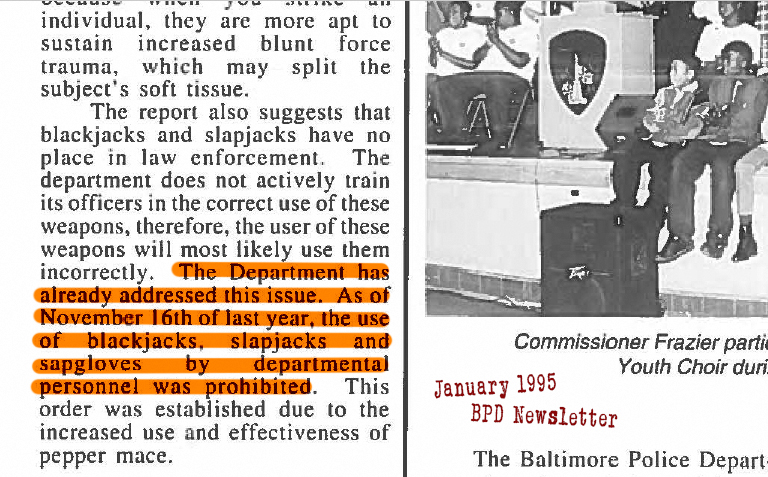 16 November 1994 - The department ended the authorized use of the Slapjack
16 November 1994 - The department ended the authorized use of the Slapjack
![]()
Slung-shot [slúng shòt]
Noun - A weight or weight attached to the end of a cord and used as a weapon
Cosh[käSH]
Noun - a thick heavy stick or bar used as a weapon; a bludgeon.
Verb - hit (someone) on the head with a cosh
$70,000 Awarded in Police Assault Case
July 19, 1994
By Norris P. West | Norris P. West, Sun Staff Writer
A Baltimore Circuit Court jury has awarded $70,000 to an East Baltimore man who said he was assaulted by two city police officers who mistakenly came to his home while searching for a suspect who lived nearby. The jury awarded $50,000 in compensatory damages and $20,000 in punitive damages to Eddie J. Duncan, 45. The panel found that Officers Michael Johnson and Vincent McCoy assaulted the man, violated his constitutional rights and falsely imprisoned him on Aug. 1, 1992. The jury's verdict came late Friday before Visiting Judge Donald G. Gilmore. Mr. Duncan filed the lawsuit on May 6, 1993, claiming the officers, acting on an arrest warrant, arrived at his home at 1227 E. Oliver St. to look for a man named Terry Williams, whose address was 1727 E. Oliver St. He said the owner of the home identified him as Eddie Duncan and told police there was no Terry Williams at 1227 E. Oliver. Mr. Duncan said the exchange occurred outside, and when he went into the house and tried to shut the door, Officer Johnson reached inside and grabbed his shirt. Mr. Duncan said the officer tackled him and Officer McCoy joined the scrap, which lasted several minutes. During that time, he said, he was beaten on the head with a hard object that resembled a blackjack. He said the officers handcuffed him and placed him in leg irons, charging him with assaulting Officer Johnson. He said he was wrongly jailed for 19 hours. The officers said Mr. Duncan initiated the physical contact by pushing Officer Johnson from the doorway, and that Officer McCoy came to his partner's aid while a fight was underway. Robert C. Verderaime, the attorney for the officers, called the verdict excessive. He said hospital records did not support Mr. Duncan's claims of severe injuries. He said he will ask Judge Gilmore to reduce the judgment.
![]()
Man Awarded Damages for Police Harassment
[FINAL Edition]
The Sun - Baltimore, Md.
Author: Siegel, Eric
Aug 11, 1994
Start Page - 1A
In what a federal judge described as a shocking case of misconduct, a Baltimore man who was a key witness in a 1991 police brutality case was himself unconstitutionally harassed by a city officer in retaliation for his testimony. U.S. District Judge Marvin J. Garbis, in a strongly worded written order, said Officer Richard Iglehart acted improperly when he stopped Matthias S. Carter without cause when Mr. Carter was driving in Southeast Baltimore two years ago. Officer Iglehart's action was "planned for months and was intended as a `payback' for Carter's testimony" in the 1991 brutality case, said Judge Garbis, who heard Mr. Carter's civil suit without a jury. "There was, without question, an evil motive for the unconstitutional stop -- the motive of harassing Carter and demonstrating to Carter {and others who would hear about it} that those who have the temerity to testify against Southeastern District police officers are going to regret having done so," Judge Garbis said.
Judge Garbis in May upheld Mr. Carter's claim that his rights were violated and awarded him damages.
Last week, the city's Board of Estimates approved payment of a $28,097 judgment to Mr. Carter -- $15,500 in damages, plus $12,597 in legal fees. Judge Garbis said that the officer's action "strikes at the heart of that part of our legal system designed to protect civil rights and "at the effective functioning of the courts." "There cannot be any toleration of harassment of witnesses testifying in our courts by any person. Even more so, there will be no toleration of police harassment of witnesses," the judge said. Mr. Carter, 53, a former police equipment salesman, spent the night in jail after the stop on charges -- later dismissed -- of illegal possession of handguns and deadly weapons. He said this week that he isn't satisfied with the amount of the award -- or the fact that the officer who violated his constitutional rights is still on the streets. "Fifteen thousand dollars? It should have been a whole lot more," he said. As for Officer Iglehart, then assigned to the Southeastern District and now a patrolman in the Eastern District, Mr. Carter said: "He should have lost his job or been severely punished." Since Judge Garbis issued his order against Officer Iglehart, the Baltimore Police Department has begun its own investigation. "The facts and circumstances are being reviewed to determine whether a departmental disciplinary action is appropriate," said Officer Robert W. Weinhold Jr., a police spokesman. Efforts to reach Officer Iglehart, 34, were unsuccessful. His attorney, Robert C. Verderaime, said he believes his client acted properly but there were no grounds for an appeal. "The court drew inferences from the testimony and resolved them in favor of Mr. Carter," he said. "While we disagree with the findings, that's what litigation is all about." Two other officers who were also used by Mr. Carter for participating in the arrest were found not liable. Matthias Carter's case is rooted in a Nov. 4, 1989, incident. At the time, he was working for Valley Police Supply in Parkville, a job for which he had a permit to carry a gun. He was moonlighting as a cashier at a 7-Eleven store in the 6600 block of Holabird Ave. in Southeast Baltimore. Shortly after midnight, on the street outside the store, Mark Hafner fired a blast from a shotgun in the air and several through his windshield, according to court records. Confronted by officers minutes later, Mr. Hafner dropped his gun and was arrested. Mr. Carter, who went to see what was happening, said he saw Mr. Hafner handcuffed face down on the ground, with "one officer lying across his feet, and another kicking the hell out of him." Mr. Hafner was found not criminally responsible for his behavior and spent two years in state mental hospitals, according to his attorney, Allan Henson, who also came to represent Mr. Carter in his suit against the police. Mr. Hafner filed suit against the officers who arrested him, charging that they used excessive force. Mr. Carter was a key witness in the trial. In September of 1991, Mr. Hafner won a $50,000 judgment against the arresting officers -- who did not include Officer Iglehart. Even before the case was decided, Mr. Carter, who had been friendly with several police officers in the Southeastern District, said he noticed a change in the relationships. "Anytime I saw any of the officers, they avoided me or gave me dirty looks," he said. Not long after the decision in the Hafner case, Mr. Carter quit his job at the 7-Eleven. He also left Valley Police Supply and went to work selling police equipment for the Maryland Troopers Association Store in Pikesville. Because his new job did not require him to sell guns, his gun permit was not renewed. Late on the evening of April 29, 1992, he said, he was returning from a trip to the Eastern Shore making sales calls to police agencies and going target shooting with a friend. When he reached Baltimore, he stopped for coffee at the 7-Eleven where he used to work. While he was in the store, he was spotted by a Southeastern District officer, who radioed Officer Iglehart, according to court records. Officer Iglehart, who had found out months before that Mr. Carter's gun permit had expired, drove to the 7-Eleven and decided to stop Mr. Carter after he left the store, records show. Almost as soon as Mr. Carter drove onto Holabird Avenue, he was pulled over by Officer Iglehart. "Carter's driving was not such as to provide reasonable cause for a stop for any traffic purposes," Judge Garbis wrote. "Iglehart stopped Carter because, and solely because, he wished to harass him." Mr. Carter had a loaded .22 Derringer and an unloaded .357 Magnum in his car, records show. He also had a trunk full of police equipment, including a blackjack. He was charged with various handgun and deadly weapons violations. Officer Iglehart's statement of charges against Mr. Carter included the "false statement" that the officer had seen Mr. Carter drunk on several occasions, apparently to "provide a fabricated justification for the stop of Carter," Judge Garbis noted. The charges against Mr. Carter were dismissed in October 1992, when a Baltimore District judge threw out the evidence, ruling that it had been improperly obtained. Mr. Carter, who left his job at the Maryland Troopers Association Store shortly after his arrest and is currently unemployed, said his experience has changed his attitude toward police. "I don't trust a cop anymore," he said. "I used to consider myself a good friend of a lot of cops. Now I feel a cop's only friend is another cop."
![]()
Better Training in Use of Force Urged for Police
[FINAL Edition]
The Sun - Baltimore, Md.
Author Hermann, Peters
5 Nov 1994
Section: Metro
Better Training in Use of Force Urged for Police
The Baltimore Police Department needs to better train its officers in the use of force against suspects and should ban two types of long-used, but unsanctioned, weapons, a consultant has concluded. A report, which was released in summary form yesterday, urges the department to adopt a comprehensive policy on the use of force that would consolidate a series of disjointed memos and training guidelines. "To an outside observer, our efforts in {training} would certainly appear to be fragmented and sporadic, at best," Col. Joseph R. Bolesta, chief of the Human Resources Bureau, wrote in a memo responding to the report. "I'm not surprised by what they found," said Police Commissioner Thomas C. Frazier. The report also called for standardized nightsticks to be issued, instead of officers being allowed to buy their own, and for a ban on weapons such as blackjacks -- small leather pouches filled with lead pellets or a steel plate. Mr. Frazier asked for the review in August after West Baltimore resident Jesse Chapman was found dead in the back of a police van after his arrest. Witnesses said officers beat the 30-year-old man, an allegation not supported by a grand jury review. The founder of the institute that prepared the report, Robert K. Koga -- who has known the commissioner since his days in San Jose, Calif. -- and an aide spent 2 1/2 days in Baltimore, at a cost of about $3,000, and are still poring over manuals as they evaluate the department. Mr. Koga founded the training and consultant center in the early 1980s after he retired from the Los Angeles Police Department. It has worked with numerous police agencies nationwide, including those in Denver, San Jose, and Dallas and with the U.S. Secret Service. The Baltimore department declined to release the full report, saying it contained sensitive tactical information, but made public Colonel Bolesta's memo outlining the institute's findings and his responses. William Pelkey, executive director of the Koga Institute, said developing a standard policy on the use of force is essential to ensure a safe department that can be trusted by citizens. "Written policies drive police departments and establish parameters in which officers function," he said. "Everything pertaining to the use of force should be together. You should look in one place and find the philosophy and the practice. When you don't have those together, you might have contradictions." The main problem in Baltimore, Mr. Pelkey said, is that department rules are "so fragmented that officers have no clue on what is authorized or not." Some recommendations by the institute may not be implemented. For example, the report calls for monthly firearms training for each officer, something Colonel Bolesta said is impractical because of a lack of money and training space. Officer Gary McLhinney, president of the Fraternal Order of Police, said he supports the institute's finding in regards to training. Until last year, he said, officers only fired their weapons once a year on a practice range. Now, they train twice a year. "That's inadequate," Officer McLhinney said. "The fact they recognize there is a problem with training is a step in the right direction." Officer McLhinney would not comment on the recommendations to ban certain equipment. Mr. Frazier said he became concerned after the Chapman incident, which is still under internal review when he learned an officer may have hit Mr. Chapman in the back with a blackjack. He said there is a "consensus of the command staff that slapjacks and blackjacks are inappropriate law enforcement tools." They most likely will be banned, Mr. Frazier said. Colonel Bolesta agreed. "We've never trained anyone to carry that equipment," he said. "That concerned us. . . . We don't issue them. But there is tacit approval for that kind of thing." The institute also recommends that the department replace the "espantoon," a 22-inch nightstick with a knurled end, with a 29-inch straight baton. Mr. Pelkey said the longer stick is safer for officers involved in a close struggle with a suspect and its smooth surface avoids unnecessary injuries to people being hit. Also on the way out could be the leather handle on the end of the nightstick, used by officers to twirl their batons. The sight of officers walking down the street swinging the stick can be unsettling to residents, some commanders feel. "The thong serves no useful purpose other than decorative and should not be considered as an addition to any future impact weapon adopted by the department," Colonel Bolesta wrote in his memo.
![]()
Baltimore Police Retire the Twirling Nightstick, ending a Century of Use
March 27, 1995
By Peter Hermann
Peter Hermann, Sun Staff Writer
Only in Baltimore is it called an Espantoon
Now, after nearly a century of use, the fabled nightstick -- used by city police officers for self-defense and subduing suspects -- is about to become a museum piece, the result of a controversial order by the department's chief. Commissioner Thomas C. Frazier, who has been at the helm just over a year, has chosen a longer baton to replace the stick now seen on the street. The rawhide thong also will become history, ending a time-honored practice of twirling the sticks. Critics say that the city is sacrificing part of its heritage and that training in how to use the new baton returns the department to an era of more violent policing. They also worry about potential conflicts of interest because the organization that recommended the change is connected to a nightstick maker. "There is an unusual amount of criticism from people who have participated in the [training] program," said Officer Gary McLhinney, president of the Fraternal Order of Police Lodge 3.
"I've heard more complaints in the past month on this issue than anything else." Mr. Frazier acknowledges that the change "flies in the face of tradition." But he says the move will standardize the sticks at one weight and length, could help reduce injuries and help officers better defend themselves. Such improvements in equipment and training are "critical in modern-day policing," he says. Of the twirling, he said, "some people find it incredibly offensive and intimidating. It sends the wrong kind of message of what the police officer is doing and what he intends to do with the stick. Would you walk to an officer twirling one of those?" The espantoon first surfaced in Baltimore at the turn of the century, when the police department issued the sticks only to night-shift officers. Before police radios officers communicated by banging their sticks on the sidewalk. And officers have found many uses for the thong -- from tourniquets to pulling drunks from the Inner Harbor. Webster's Third Edition dictionary defines the term: "Espantoon, Baltimore, a policeman's club." The term is derived from the word "spontoon," a weapon carried by officers in the Roman legion, according to a police department training bulletin. Between 22 and 26 inches long and made of seasoned hickory, maple or locust wood, the club -- described in a 1960 Sun headline as "The Policeman's Best Friend" -- has become part of Baltimore lore.
One 1947 Sun article, headlined "Swing Class -- In Blue," explained the intricacies of nightstick twirling. Even then, the article noted, police commanders expressed concern about the image that twirling presented but were reluctant to change. "After all, telling a policeman not to swing his espantoon would be like asking a happy man not to whistle," it said. For decades, Baltimore police officers have bought their own sticks -- most often from other officers who turned them out on basement lathes. Officer Joseph Hlafka, known throughout the department as "Nightstick Joe," started making the sticks early in his career. He charges $30 a stick, some of which are customized with nicknames. Now, after selling more than 22,000 sticks nationwide, he's losing his local market. "If there is an officer out there who is not carrying one of my sticks, he is not a member of the Baltimore Police Department," he boasted. The 27-year veteran, who patrols the Inner Harbor, criticized Mr. Frazier for "not considering the historical aspect in all this. It's just a shame. All this history and he's just throwing it by the wayside."Officer Hlafka defended the thong as a safety device that prevents people from grabbing the stick and taking it away. The twirling, he said, keeps people from sneaking up on an officer. "I think people like to see us twirl the stick," added Officer McLhinney. "Criminals don't like to see us twirl the stick. I have BTC heard that twirling the stick is intimidating. It's supposed to be intimidating. It's a stick." But the commissioner said the change in nightsticks comes from "an analysis of use and injuries and complaints both in terms of internal investigations and image and perception. As we try to become a more community-oriented agency, it's a change I felt necessary to make." He said he also has "serious concerns" about the variable weight of the privately made nightsticks. "The larger the circumference and the heavier that stick is, the more it is like a bat," he said while expressing concerns that grooves in the espantoon's handle can cause injuries. James J. Fyfe, a professor of criminal justice at Temple University and an expert in police use of force, said it is important that departments have standardized equipment. "They should all have the same [nightstick]," said Mr. Fyfe, a former New York City police officer, adding that many departments across the country are going to the straight baton. Last year, after Mr. Frazier found Baltimore's police training to be inconsistent, he turned to the California-based Koga Institute. The institute also is used by the San Jose Police Department, where the commissioner worked before coming to Baltimore. Koga evaluators found that regulations spelling out when Baltimore officers could use force were contained in a series of disjointed memos instead of in uniform guidelines. Koga proposed eliminating officers' "slapjacks" -- hand-held pouches filled with lead -- and changing from the espantoon to the baton. The institute was founded in 1973 by Robert K. Koga, a former Los Angeles police officer who now travels the country overseeing training classes and testifying in trials as an expert witness on police use of force. The Koga method is described in promotional materials as a "complete system" similar to aikido, a martial art with Asian roots that combines jujitsu and Greco-Roman wrestling. The training method has been used by many departments, including the U.S. Secret Service, the Saudi Arabia Royal Guards and the Denver Police Department.
William Pelkey, executive director of the Koga Institute, denied that the training is violent.
"It is specifically designed for police officers for what they need on the street," he said. "It is control, not punishment -- the quickest and safest way for all concerned." But one Baltimore police officer who recently went through the training said instructors emphasize a two-handed strike aimed at the chest or joints. Previous training had officers aiming for large muscle mass or the legs. "This is the most dangerous thing I've seen," said the officer, who spoke on the condition that he not be named. The officer said many Baltimore officers prefer to use pepper spray.
Don Cameron, who once worked for Koga and is now a police training consultant in California, said Mr. Koga has "got some very traditional ideas. A lot of police officers who aren't in the martial arts don't understand him. I think that's where some of the turnoff is."
The city Police Department is authorized to spend up to $60,000 on Koga training, which includes classes in use of the new nightstick and a variety of self-defense and arrest techniques. Officer McLhinney, the police union president, says the relationship between Koga and the department holds the potential for conflicts of interest. He notes that Mr. Koga also runs Sueko Inc., which makes nightsticks. And Koga only will endorse departments that use a nightstick fitting its precise specifications. "Koga came in and recommended training which only it offers, and recommended a nightstick which only it sells," said Officer McLhinney, who is concerned about the bid process. "We had a real hard time trying to get good batons made," said Virginia McAlpine, the office manager for Sueko, which is located in the same building as the Koga Institute.
Other companies can make the baton, she said, but would probably have to do it on special order to fit Koga's requirements. She added that she would "be very surprised" if Baltimore bought the $19 nightsticks that Sueko makes. "I would certainly understand if they would want to buy them from a local vendor." Baltimore purchasing officials, who said the city plans to put the nightstick contract out to bid by the end of the week, have identified 15 to 18 companies that could be interested in making the 3,000 sticks. For example, Brown Wood Products of Northfield, Ill., could make 29-inch straight batons for $7.25 each, said Jini Hubbell, the company's customer service manager. Mr. Pelkey said Mr. Koga hasn't decided whether to bid on Baltimore's contract. It might be seen as a conflict because the institute provided specifications for the city, he added. "I'm not too sure that this kind of a contract would be in the best interest of the institute or Sueko Inc.," he said. "Making money and providing services sometimes need to be kept separately."
![]()
WOUNDED BY OWN PISTOL
Jun 26, 1921
Policeman Says Weapon Exploded as he was Walking on Street
Wounded by his service pistol, Patrolman - George Haas, Central District, was taken to Mercy Hospital yesterday. Haas told Sergeant Stempel that he was walking on Fallsway near Bath street when the weapon suddenly exploded. The bullet entered his right leg Haas was unable to explain how the Cartridge exploded. Several months ago Police Commissioner Gaither issued an order for policemen to keep the firing pin of their pistols on an empty shell. An examination of Haas' pistol revealed four cartridges and one empty shell.
![]()
The word "Cosh" is sometimes used loosely for any blunt instrument.
"Nightstick" - For the sludge metal band, see Nightstick (band). For the Transformers character, see Nightstick (Transformers). along with espantoon, blackjacks, slapjacks, we also used non-traditional weapons to strike, most commonly was a flashlight, and then there was Pistol-whipping is the act of using a handgun as a blunt weapon, wielding it as if it were a club or baton. "Pistol-whipping" and "to pistol-whip" were reported as "new words" of American speech in 1955, with cited usages from the 1940s. However, both the term and the practice trace back to the Wild West of the 19th century also known as buffaloing.
Paul Wellman notes that clubbing an opponent with the butt of a gun held by its barrel, as seen in some Westerns, is problematic. First, guns are designed for shooting, not as a club. Second, the danger of an unintentional discharge could fatally wound the "clubber". Additionally, many handguns, specifically revolvers, lack sufficient structural strength. Striking a target in this manner could cause damage to the weapon. Finally, rotating a gun so that it can be held by its barrel takes extra time. The loss of time may be crucial during a fight.
Instead, pistol-whipping should be done with the gun held in an ordinary manner, hitting the target with an overhand strike from either the long, heavy barrel of the gun or the side of the gun in the area of the cylinder. It was a fairly common and highly successful way to knock a man unconscious (assisted by the heavy weight of the handguns of the day), and was known as "Buffaloing", with the verb form being "to Buffalo". This form of pistol-whipping with an 1860s-style revolver was tested on the Spike TV television show Deadliest Warrior. Wyatt Earp was known for buffaloing people, in fact, he was quick to buffalo someone. While on the force, we were told not to do it, and you think to yourself, why would I want to do that, it could fracture their skull and kill them, and then the day will come along, when you are in a fight that leaves you in a place, where you can’t put your gun away, you are unsure about shooting them, so you hit them with whatever you can find, I have nailed someone with the butt of my gun, with a flashlight, one time on a ground, running out of wind, fighting for my life, I grabbed something off the ground and hit him with it. It is not a schoolyard fight when people fight police; they are not fighting for a girl or fighting street cred. They want the officer’s gun, and if they get the gun FBI statistics show more than 80% of the time, the officer if shot with it. So when a person is fighting and the officer is alone waiting for backup, he or she and I know I would use whatever I could find to make sure I won that round. The testers showed that using the long barrel of a Colt revolver in a whipping motion produced enough force to fracture a skull and could potentially kill a man with a single blow.
In modern times, pistols are much more compact, typically extending no more than approximately four inches past the trigger, making them much less suitable for pistol-whipping with the barrel than their predecessors. Because of this, pistol-whipping is now mainly performed by hitting a person with the base of the grip while still holding it normally, striking in a downwards motion. This adds the weight of the gun to the force of the blow and allows the metal frame (rather than the barrel) to be the point of impact but deprives the blow of the leverage provided by barrel length.
Pistol whipping may leave unusual lacerations on the body of the injured due to various protruding details of the pistol. Semicircular or triangular lacerations on the skin may be produced by the butt of a pistol. The magazine well and base produce rectangular lacerations on the skin. These lacerations can vary in depth and severity, but if "whipped", fractures are common. Pistol-whipping should not be confused with butt-stroking, a close combat military discipline.
![]()
Old Police Baton
A truncheon or baton (also called a cosh, billy stick, billy club, nightstick, sap, blackjack, stick) is essentially a club of less than arm's length made of wood, plastic, or metal. They are carried for forced compliance and self-defense by law-enforcement officers, correctional staff, security-industry employees and (less often) military personnel. Other uses for truncheons and batons include crowd control or the dispersal of belligerent or non-compliant people.
A truncheon or baton may be used to strike, jab, block, bludgeon and aid in the application of armlocks. The usual striking or bludgeoning action is not produced by a simple and direct hit, as with an ordinary blunt object, but rather by bringing the arm sharply down while allowing the truncheon to pivot nearly freely forward and downward, so moving its tip much faster than its handle - effectively a slingshot action, only without releasing. Sometimes, they also are employed as weapons by criminals and other law-breakers because of their easy concealment. As a consequence, they are illegal for non-authorized civilian use in many jurisdictions around the world. They have a common role to play, too, in the rescuing of trapped individuals—for instance, people caught in blazing cars or buildings—by smashing windows or even doors.
History
19th-century police truncheons in the Edinburgh Police Centre Museum
A modern wooden baton
In the Victorian era, police in London carried truncheons about one-foot long called billy clubs. According to the Online Etymology Dictionary, this name is first recorded in 1848 in American English as slang for a burglars' crowbar. The meaning "policeman's club" is first recorded 1856. The truncheon acted as the policeman's 'Warrant Card' as the Royal Crest attached to it indicated the policeman's authority. This was always removed when the equipment left official service (often with the person who used it). Earlier on the word was used in vulgar Latin (bastο - a stick helping walking, from basta - hold).
The Victorian original has since developed into the several varieties available today. The typical truncheon is a straight stick made from wood or a synthetic material, approximately 1.25 inches (32 mm) in diameter and 18–36 inches (460–910 mm) long, with a fluted handle to aid in gripping. Truncheons are often ornamented with their organizations' coats of arms. Longer truncheons are called "riot batons" because of their use in riot control.
Truncheons probably developed as a marriage between the club or military mace and the staff of office/scepter.
Straight batons of rubber have a softer impact. Some of the kinetic energy bends and compresses the rubber and bounces off when the object is struck. The Russian police standard-issue baton is rubber, except in places such as Siberia, cold enough that the rubber can become brittle and break if struck.
The traffic baton is red to make it more visible as a signaling aid in directing traffic. In Russia, traffic batons are striped in black and white for the same reason.
Until the mid-1990s, British police officers carried traditional wooden truncheons of a sort that had changed little from Victorian times. After the early 1990s, forces replaced truncheons with side-handle and collapsible batons for all but ceremonial duties.
The NYPD used to use two kinds of batons depending on the time. The one for daytime was called a day-stick and was 11 inches in length. Another baton, that was used at night, was 26 inches long and called a night-stick, which is where the word nightstick came from. The night-stick was longer so it could provide extra protection which was thought to be necessary at night.
Strike Zones - Before the 1970s, it was common for law enforcement in the United Kingdom to "brain" suspects (strike their heads) in order to stun them or knock them unconscious. However, this was unreliable and potentially fatal. Civil lawsuits and claims of police brutality resulted in better training for officers. In modern police training, it is not permitted to hit the skull, sternum, spine, or groin unless such an attack is unavoidable. The primary targets now are nerves, such as the common peroneal nerve, and large muscles, such as the quadriceps or biceps.
![]()
Espantoon – Straight-Stick – Straight-stick LAPD riot officers with straight sticks during a protest in Los Angeles.
A straight, fixed-length baton (also commonly referred to as a "straight stick") is the oldest and simplest police baton design, known as far back as ancient Egypt. It consists of little more than a long cylinder with a molded, turned or wrapped grip, usually with a slightly thicker or tapering shaft and rounded tip. They are often made of hardwood, but in modern times are available in other materials such as aluminum, acrylic, and dense plastics and rubber. They range in size from short clubs less than a foot in length to long 36-inch (91 cm) "riot batons" commonly used in civil disturbances or by officers mounted on horseback. Straight-sticks tend to be heavier and have more weight concentrated in the striking end than other designs. This makes them less maneuverable but theoretically, would deliver more kinetic energy on impact. Most agencies have replaced the straight-stick with other batons because of inconvenience to carry, and a desire for their officers to look less threatening to the community they serve. Despite having been replaced by side-handle and expandable batons in many (if not most) law enforcement agencies, it remains in use by many major departments in the US, such as the Baltimore, Denver, Sacramento, Long Beach, Santa Ana, Philadelphia, San Francisco, and Riverside Police Departments, and are used by NYPD Auxiliary Police officers, as well as many Military Police forces around the world.
![]()
USE TWO KINDS OF PISTOLS
Both, Single and Double Action pistols carried by Baltimore Policemen. It’s not generally known that two kinds of revolvers are in use in the Baltimore police department, part of the force carrying the old-time single-action pattern and the others having the modern double action kind. The question has therefore arisen as to which Is. the most serviceable. No one knows better than a police officer that when a revolver is needed in his work, it is needed badly. The weapons are of .38 caliber, and it is said that the single action pattern cannot be used nearly so effectively as the double-action in a struggle with a desperate man. If there is a clinch and the two fall, the officer finds himself forced to use his pistol he will have difficulty in doing it quickly with a single action weapon. With the double-action pattern, he can fire all the cartridges in it as rapidly as he can pull the trigger, and it will be almost impossible for a man to fasten on him so that he cannot shoot. Sergeant Saunders says that ''Ike" Cornish, colored, only succeeded in doing him up because he had a single-action revolver. "The double-action revolver is the best for police duty," said Marshal Hamilton yesterday, and he explained the difference by experimenting with one of each pattern. "You see you can take this double action revolver, handle it one-handed, keep pulling the trigger and empty every chamber. In the shortest time. If firing at short range, you are sure to hit your mark. With the single-action revolver, you must pull back the hammer, aim and then pull the trigger to fire. This takes time that may enable your antagonist to knock the weapon from your hand, maybe overpower you and possible pick up the revolver and use it against you.” – “In our business, we need a revolver like the double-action to use in an Instant," said Captain Barranger, of the Central district. "They are by far the best. All my sergeants and many of the older patrolmen in my district have them. Whenever I get a new man I am furnished with a double-action revolver for him. This I give to an older man because he has more experience in handling a revolver and I give the single-action revolver to the new man." The double-action revolver was adopted by the Police Board seven or eight years ago, with the understanding that It was to be substituted for the single-action as they become rusted and worn and unfit for service. By this method, though a slow one, many members of the force now have double-action revolvers. Secretary Kinsey, of the Police Board, says, however, that he has no record by which he can tell the number of each kind now in service. An officer is furnished with a revolver by the department and by an order passed a few years ago he keeps it except when he goes out of the city on a leave of absence. Then he surrenders it to the captain of his district. If he leaves the department, of course, he gives it up. Each re-order costs about $15. Commissioner Morris and Mr. Kinsey think that the single-action revolver is as good as any for departmental use and will accomplish as good results.
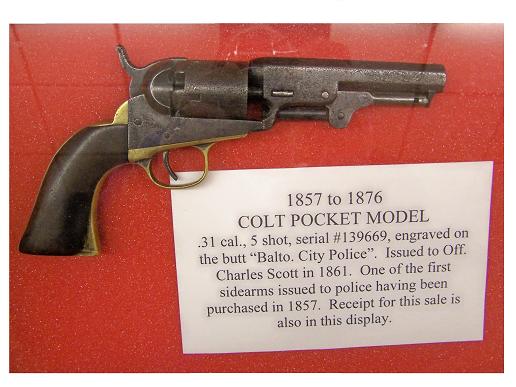 Courtesy Bruce Green
Courtesy Bruce Green
![]()
POLICE REVOLVER PRACTICE
10 December 1896
It would possibly be considered a random assertion to state that seven hundred men or so might suddenly take to revolver practice in Baltimore, but there is a possibility that such a state of things will come to pass. If it does, the men will be the Baltimore Police Force, in whom the people of this city have the utmost confidence except when they pull their pistols to aim at a dog or anything. That needs a few holes plunked through it for the general good of the community. Dr. Samuel J. Fort, of Ellicott City, who is one of the expert revolver shots of the country, intends to interview the Police Commissioners about putting the men into practice at targets, and Dr. Fort is enthusiastic enough to agree to instruct the men for a time until he can pick two or three men who will themselves be competent to act as Instructors.
At least one of the commissioners believes that the men should know how to handle the arms with which they are entrusted, and it is possible that the others are equally progressive.
“Every man on the force ought to shoot at least twice a month,” said Dr. Fort yesterday. “That could easily be arranged with the comparatively small force in Baltimore City. If only eighty men shot in one day, and the practice days numbered only two each week. Each man could shoot at least once a month, or twelve times a year, and the improvement would be marketed.” – “I say the comparatively small force In Baltimore because it must be remembered that in New York 4000 men are compelled to practice under the direction of Police Captain Petty the chief instructor and champion shot. There the shooting goes on every day and 150 men are instructed each day. “That a mere knowledge of how to hit what you aim at is not, as some claim. A temptation to use the pistol is proved in New York, and Captain Petty is one of the best marksmen in the world has never had occasion to fire at anybody. In years of service as a patrolman. His prowess is so well known, however, and the fleeing evildoer has such a dread of shot whom he knows can wing his man at will that the pursued throws up his hands and gives himself up."
Dr. Fort thinks that a ten-yard range, at which the men would begin work, could be arranged easily and at a small cost in the central police station gymnasium or another convenient place. The targets made by the men would be recorded, and, after a drilling, they would be surprised that their first targets were so bad. Every target that has been shot up to date in New York has been recorded in books kept for the purpose.
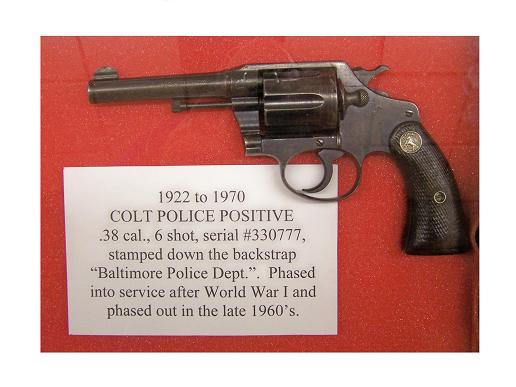
Courtesy Bruce Green
Police Pistol Practice
15 Dec 1896
Baltimore’s police force has the reputation of being one of the best in the country and it thoroughly deserves this reputation. Nevertheless, there is one particular in which it might be improved, and that is in the knowledge and use of the revolvers with which Its members are equipped. Fortunately, these weapons have not been often required to enforce obedience to law in Baltimore, and consequently many innocent and unoffending persons are still alive who might have been hurried to untimely graves had our police been called upon to make practical use of their artillery. We say innocent and unoffending persons because It is clear from such experiences as we have had that when the police get their guns out the general public is in greater danger than the object at which they aim. This has been illustrated on several occasions In which these local William Tells were called on to dispatch dogs or other animals which were offending against the peace, dignity, and safety of the city. The wonderful marksmanship displayed in these nerve-trying emergencies has been known to cause a whole neighborhood to close doors and window blinds in precipitate panic, and sections or the town exposed to these alarming skirmishes to suddenly assume the appearance of a dreadful state of siege. The exciting encounter which the force had Saturday with the gay and festive cow from south Baltimore, which has probably by mistake been given Scotch Whiskey instead or water to mix with her milk, illustrates how fearfully and wonderfully some or "the finest" can shoot. The fact that nobody was killed but the cow calls both for an explanation and for a solemn expression of public gratitude. How many patrolmen fired at her as she ran the police gauntlet with mocking, gambols, and jeering remarks in the choicest cow vernacular? We do not undertake to say, but the police commissioners are reported as declaring that another such attack on the city would exhaust all the ammunition in the municipal arsenals. And after a prolonged and exhausting conflict, Which gave rise to rumors of a Spanish invasion, the police, it is said, were about to appeal to the fire department to turn their hose on the hilarious animal when she fell from the exhaustion of protracted victory and was murdered with a common every-day axe by one of her uniformed foemen Seriously, it would really be good thing to teach the young and old policeman something about the pistol which he is required to carry. At present what many of them don't know about the subject would form an entertaining comedy, if it were not for the fact that it is no joke to be handling a loaded revolver which you have only a distant acquaintance with. The suggestion that the police should be given regular instruction in this direction and opportunities for frequent target practice under a competent person is a good one and should be adopted. If it accomplishes nothing else, it will at least prevent the Waste of much good powder and ball on occasions like that of the “Baltimore Cow Battle of 1896”; Saturdays will tend to no longer exist, adding to the protection of the members of the community, and the members of its police force, from the dangers, “incident” to the handling of their own weapons.

Courtesy Bruce Green
![]()
POLICE and REVOLVERS
29 December 1896
President Edson M Schryver, of the Baltimore Police Board, has received a letter from Police Commissioner Parker, of the New York Police Department in reply to the request for information as to revolver practice among the “Bluecoats”, of New York. The Baltimore Commissioners have o definite action in the matter, but the question of pistol practice is being considered by them. Following is the letter from Commissioner Andrew D Parker: “Our school of pistol practice was established in the fall of 1895, using the rifle range in the armory of the Eighth Regiment, National Guard, of this city. The School was placed under the instruction of Sergeant (Now acting Captain) Wm. E. Petty, who has for many years held the Championship for Pistol Practice of the United States. He was assisted by two or three experts selected from the department, who attended to marking, reloading cartridges, the manufacture of bullets keeping of our records, etc. “We found that the school resulted in a marked improvement in the marksmanship of our men, so much so that in the summer of 1896, on five or six different occasions when it became necessary for our officers to use their pistols against fleeing criminals, they did so with startling success. Four and I think five; escaping criminals were instantly killed as the result of the excellent marksmanship of our officers, and in each case, the officer was absolutely absolved from all blame by the department and the courts. “The general averages comparing the first scores and the later scores show a very marked improvement. This school was preceded by a careful examination into the merits of various revolvers, and the ultimate adopting of a new32 caliber revolver. We found that the men had been very indifferently equipped with old useless and frequently borrowed revolvers. Each man must now own his own revolver, which must be stamped with his shield number (New York term) and must always be available. “I am very much interested in your proposition to establish a school, and if any of our officers can be if service to you I shall be delighted to have them assist you in any way in their power.” Commissioner Schryver almost lost his breath when he read that part of the letter detailing “startling success” with which five escaping criminals were instantly killed by New Yorkers. He seemed to feel that his marksmanship was just a little too accurate for Baltimore uses, but he has the consolation of knowing that shooters, at any rate, did not do what Baltimore patrolmen on commerce street did some years ago. The man in question aimed at a mule which had a broken leg, the bullet missed the mule, which was lying by the curbstone, and went through the second story window of a liquor house and nearly frightened a porter out of his wits. It was suggested to the commissioner that a man who could shoot so as to instantly kill could also shoot so as to stop a runaway criminal without killing if such were the orders given
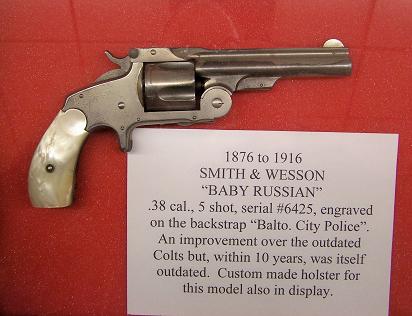 Courtesy Bruce Green
Courtesy Bruce Green

Courtesy Bruce Green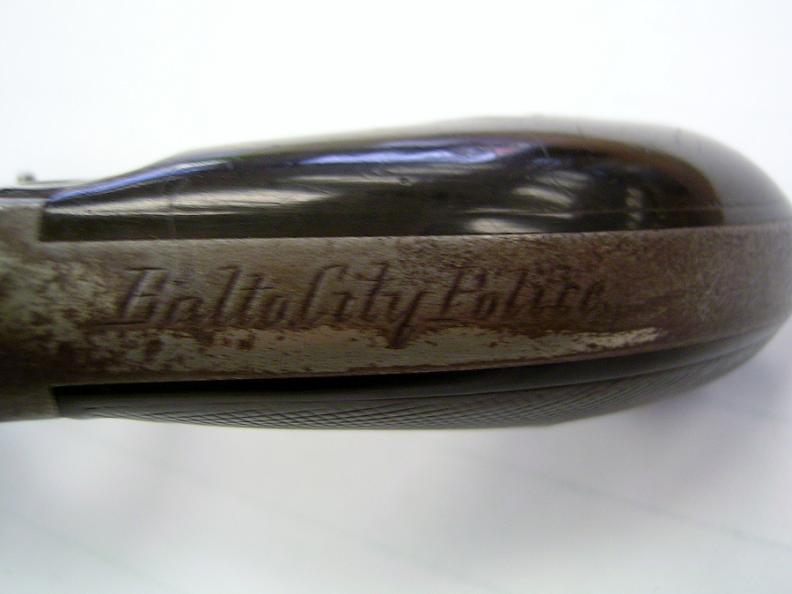
Courtesy Bruce Green

Courtesy Bruce Green

Courtesy Bruce Green

Iron Claw
![]()
Police Advances Render Iron Claw Obsolete
Jun 17, 1978;
pg. B20
The iron claw, just like the guillotine, machine gun, shock baton and Billy knife, has outlived its usefulness and has become a dying piece of optional police equipment – unless you happen to be one of the “old veterans.” “We progressed beyond the iron claw,” the president of the local firm to distribute police equipment said recently. “It’s a punishment type of equipment. If anything, it was detrimental to law enforcement.” Robert V. Wantz, president of Maryland police supply, Inc., Said his firm stop supplying the iron claw the law enforcement officers about three years ago after the demand had decreased substantially. “No question they can still be bought.” Mr. Wantz said. The iron claw is a single handcuff that can be snapped onto a person’s wrists and controlled by a T-shaped handle. Once secured to the rest it is “crank” to remove any slack. After that, any sudden voluntary or involuntary movement can cause considerable pain or even a broken wrist. Dennis S. Hill, a police spokesman, said officers are allowed to use the device if they purchase one with their own funds. A salesman for another local supplier of police equipment, who preferred to remain anonymous because of the "adverse publicity the claw draws,” said the item retails for about $30. “We probably sell about three in a six-month period. It takes a special skill to use it properly. It’s quite a vicious device… And an instrument of persuasion,” he added. “Most people are afraid of it. I had one cop who claimed to use it to break a man’s jaw.” However, Millard S. Rubenstein, the Police Department’s legal advisor, said he could not recall a single serious case where departmental charges resulted from improper use of the iron claw. Police agent Michael D. Bass, another police spokesman, said he had seen very few of the Aren’t clause during his six years on the force and cannot himself recall it’s being used in making an arrest. “I would say the radio [walkie-talkie] and radio cars caused the demise of the claw,” agent Beth said. “Most of the guys who will carry it now would be old-timers.” He said the claws were most useful when there were many foot post in the city and no immediate method of summoning either backup help or a patrol wagon. “You had to go to a call box to call for a wagon [after making an arrest].” Agent Bass said, “they [prisoners] would go digging and scratching all the way.” He said that by cranking the device it could easily be used to “secure a prisoner.” But now he said, the Claw is mostly a thing of the past unless you happen to run into one of the older veterans on the force. “It’s just a conversation piece now,” he added. Mr. Wantz said the manufacturers of police equipment have not developed many new items in recent years and the most popular piece of equipment now seems to be a heavy aluminum flashlight that can be used as a nightstick. It can be purchased by law enforcement officers for about $18-$28 he said.
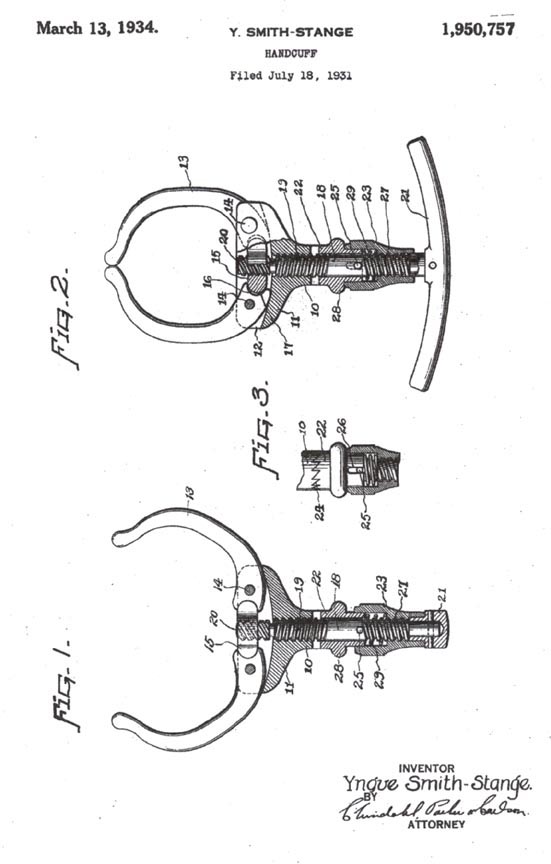
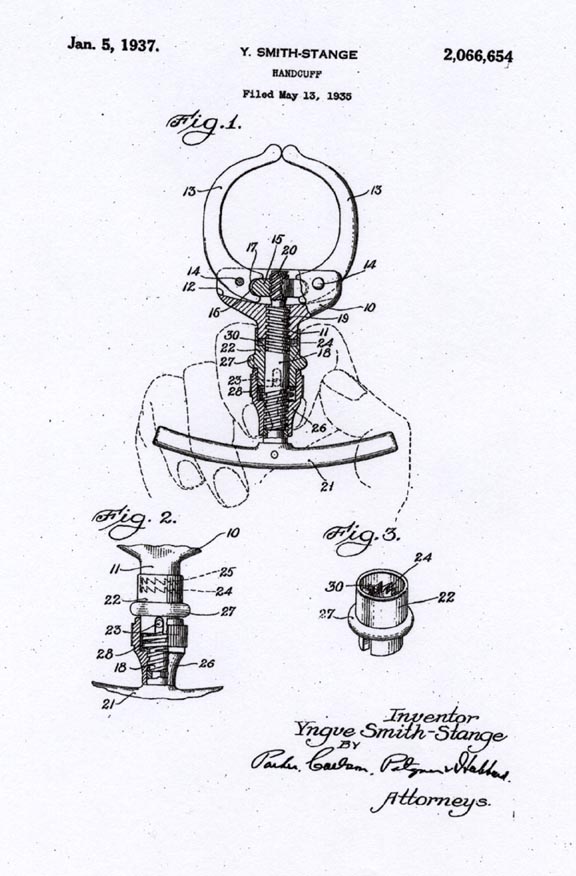
![]()
Officer custom-makes nightsticks BALTIMORE CITY
[FINAL Edition]
The Sun - Baltimore, Md.
Author Hilson, Robert
Apr 9, 1993
Start Page: 4.B
Section: METRO
Document Text
In his first week with the Baltimore Police Department 24 years ago, Officer Joseph Hlafka broke five nightsticks while on duty.
"Four times I was protecting myself from people who refused to leave a corner," Officer Hlafka recently recalled.
The fifth nightstick fell from his hand and broke apart. "So I started to make my own, and I got good at it real good," Officer Hlafka said. "Mine don't break easily like some of the other ones." In making the nightsticks, he uses woodworking skills he learned in the Police Boys Clubs, and stronger wood. His colleagues liked his first models and asked him to make theirs. Since then, Officer Hlafka, known as "Nightstick Joe," has made thousands of nightsticks for fellow officers. "I realized that I would get hurt if I continued to use their {the police department's} equipment," he said. "I just make a better nightstick. Once I made them, they started going like a house on fire." The nightsticks that Officer Hlafka, 55, makes in the crowded basement workshop of his south Baltimore rowhouse are requested by police officers in Baltimore and other cities, and in Canada and France. "They hear about me and get in touch with me and before too long, I can make them a good nightstick," Officer Hlafka said. More than a dozen nightsticks sway from the ceiling of his workshop, waiting to be claimed by officers. Some officers have requested terms such as "Nighty Night," "Ouch," "The Man," "Bye Bye" and "Kiss Me" to be engraved on their nightsticks. Several department-issue nightsticks are also in Officer Hlafka's basement. "This is a piece of junk," he says, grabbing one of the nightsticks that is lighter in weight than his. "I could snap it in a heartbeat." Pine nightsticks, 21 1/2-inches long, are issued to every trainee in the Baltimore Police Department's Education and Training Division for use for self-defense and crowd control. City officers use only wooden nightsticks, which inflict less physical damage than the plastic nightsticks used by some other police departments. Officer Hlafka uses strong Bubinga wood from Brazil and South Africa, meticulously rounding each nightstick on a lathe. Then he sands the weapon -- 24 inches long and 2 inches in diameter -- until it is smooth. It takes him about two hours to make a nightstick, a knocker in police parlance, and he charges $30 for it. He earns about $5 profit on each nightstick. Sgt. Thomas Maly, who works in the education and training division, said it's somewhat of a tradition for new officers to buy nightsticks from Nightstick Joe. "A lot of them seem to like his nightsticks," Sergeant Maly said. "They conform to the same standards but have a different finish. They're more perfect." Officer Hlafka said he never imagined the popularity of his nightsticks. "But I've done pretty well over the years and I guess the nightsticks have, too," he said. "I make it to last because it should last, and I make them any way that they want to have them made. I think that I've known every officer on the {city} force for the last 20 years." A foot patrolman assigned to the tactical section at the Inner Harbor, he works an eight-hour night shift, then puts in four to six hours making the "Hlafka model" nightsticks. When he's in his workshop, he and his wife communicate via an intercom system. "The only thing that changes on each nightstick is the head. The rest of it is the same. People have different grips," he said. "When an officer grabs a piece of wood, it's got to feel comfortable." Officer Hlafka said he's used two nightsticks since he began making them. "The first one I made, I had for almost 10 years until it got stolen. The one I have now I've had for 15 years," he said. Capt. Michael Bass, of the Northern District, said Officer Hlafka is somewhat legendary because of his nightsticks. "You mention his name and everybody says, `Oh yeah, I know him,' " Captain Bass said. He said when he was assigned to the police academy, Officer Hlafka would meet with most trainees, show them his nightsticks and take their orders. "And then a couple of weeks later, he'll pull up and pass them out," Captain Bass said. Reproduced with permission of the copyright owner. Further reproduction or distribution is prohibited without permission.
![]()
Better Training in use of Force Urged for Police
[FINAL Edition]
The Sun - Baltimore, Md.
Author Hermann, Peter
Nov 5, 1994
Start Page: 1.B
Section METRO
Document Text
The Baltimore Police Department needs to better train its officers in the use of force against suspects and should ban two types of long-used, but unsanctioned, weapons, a consultant has concluded. A report, which was released in summary form yesterday, urges the department to adopt a comprehensive policy on the use of force that would consolidate a series of disjointed memos and training guidelines. "To an outside observer, our efforts in {training} would certainly appear to be fragmented and sporadic, at best," Col. Joseph R. Bolesta, chief of the Human Resources Bureau, wrote in a memo responding to the report. "I'm not surprised by what they found," said Police Commissioner Thomas C. Frazier. The report also called for standardized nightsticks to be issued, instead of officers being allowed to buy their own, and for a ban on weapons such as blackjacks -- small leather pouches filled with lead pellets or a steel plate. Mr. Frazier asked for the review in August after West Baltimore resident Jesse Chapman was found dead in the back of a police van after his arrest. Witnesses said officers beat the 30-year-old man, an allegation not supported by a grand jury review. The founder of the institute that prepared the report, Robert K. Koga -- who has known the commissioner since his days in San Jose, Calif. -- and an aide spent 2 1/2 days in Baltimore, at a cost of about $3,000, and are still poring over manuals as they evaluate the department. Mr. Koga founded the training and consultant center in the early 1980s after he retired from the Los Angeles Police Department. It has worked with numerous police agencies nationwide, including those in Denver, San Jose, and Dallas and with the U.S. Secret Service. The Baltimore department declined to release the full report, saying it contained sensitive tactical information, but made public Colonel Bolesta's memo outlining the institute's findings and his responses. William Pelkey, executive director of the Koga Institute, said developing a standard policy on the use of force is essential to ensure a safe department that can be trusted by citizens. "Written policies drive police departments and establish parameters in which officers function," he said. "Everything pertaining to the use of force should be together. You should look in one place and find the philosophy and the practice. When you don't have those together, you might have contradictions." The main problem in Baltimore, Mr. Pelkey said, is that department rules are "so fragmented that officers have no clue on what is authorized or not." Some recommendations by the institute may not be implemented. For example, the report calls for monthly firearms training for each officer, something Colonel Bolesta said is impractical because of a lack of money and training space. Officer Gary McLhinney, president of the Fraternal Order of Police, said he supports the institute's finding in regards to training. Until last year, he said, officers only fired their weapons once a year on a practice range. Now, they train twice a year. "That's inadequate," Officer McLhinney said. "The fact they recognize there is a problem with training is a step in the right direction." Officer McLhinney would not comment on the recommendations to ban certain equipment. Mr. Frazier said he became concerned after the Chapman incident, which is still under internal review when he learned an officer may have hit Mr. Chapman in the back with a blackjack. He said there is a "consensus of the command staff that slapjacks and blackjacks are inappropriate law enforcement tools." They most likely will be banned, Mr. Frazier said. Colonel Bolesta agreed. "We've never trained anyone to carry that equipment," he said. "That concerned us. . . . We don't issue them. But there is tacit approval for that kind of thing." The institute also recommends that the department replace the "espantoon," a 22-inch nightstick with a knurled end, with a 29-inch straight baton. Mr. Pelkey said the longer stick is safer for officers involved in a close struggle with a suspect and its smooth surface avoids unnecessary injuries to people being hit. Also on the way out could be the leather handle on the end of the nightstick, used by officers to twirl their batons. The sight of officers walking down the street swinging the stick can be unsettling to residents, some commanders feel. "The thong serves no useful purpose other than decorative and should not be considered as an addition to any future impact weapon adopted by the department," Colonel Bolesta wrote in his memo. Reproduced with permission of the copyright owner. Further reproduction or distribution is prohibited without permission.
![]()
Police Get Rid of an Old Weapon Baton Training Aims to Supplant use of Traditional Nightstick
August 11, 1996
| By PETER HERMANN | PETER HERMANN, SUN STAFF
Bidding farewell to the fabled espantoon, Baltimore police are wielding a new nightstick on city streets and practicing new ways of confronting unruly citizens. The California-based Koga Institute is teaching officers procedures for searching, subduing and arresting people. They are based on martial arts, and the police chief hopes these techniques win minimize injuries to officers and citizens. Officers also are learning several maneuvers with the new stick -- balled a baton -- which is replacing the espantoon, a nightstick used since the turn of the century. Although officers seem to like the training, the program got off to a rocky start. Some police commanders have been reluctant to change, and instructors privately have complained that some district sergeants and lieutenants have tried to steer officers away from becoming Koga trainers. Commissioner Thomas C. Frazier, over the institute's objections, decided to limit how officers use one baton maneuver -- a two-handed jab to the chest -- because he is concerned someone could be killed. Robert K. Koga, a former Los Angeles police officer, founded the institute in 1973. The self-defense techniques he teaches are based on Aikido, a combination of Greco-Roman wrestling and jujitsu.
While the baton may be the most noticeable addition to the police force, officers are learning a wide range of Koga defense techniques. "The Koga Method is a complete system, capable of providing an officer with the tools needed to not only safely control a suspect, but control the officer as well," company brochures say. Frazier concluded more training was needed soon after he arrived in Baltimore in 1994 and spent several nights on the street, watching his officers make arrests. "What I saw frightened me," he said. Standard techniques were lacking, he said, putting suspects and officers in danger.
Then there was the famed espantoon. Frazier thought the time-honored tradition of twirling the stick was intimidating to citizens, and he worried about injuries of people hit by the stick. "There was never any formal espantoon training," said Lt. Gerard G. DeManss, a 25-year veteran who heads the Koga training program in the department. "The department gave you something and didn't tell you how to use it." So far, 500 officers have been trained in the new techniques and given the new baton, which is 29 inches long and has no handle. The espantoon is shorter and thicker and has a grooved handle and strap. Instructors estimate it will take up to five years for all 3,100 department members to complete the program, which has cost the city $118,000 in the past two years.
![]()
Emphasis on technique
This month, about two dozen police officers completed their last day of Koga training on the fifth floor of the old Signet Bank building on Guilford Avenue. Lining up on blue wrestling mats, they practiced how to arrest and search suspects, including having them lie face down on the ground to be handcuffed -- a departure from making suspects line up against a wall. The idea is to keep the suspect off balance, giving the officer leverage in case the prisoner tries to escape.
![]()
The instructors emphasized the importance of technique.
For example, when searching a suspect for a weapon, seven areas are checked, starting with the waistband, the most common hiding place. "If you start jumping around, you will miss something," Sgt. Ronald Fleming told the group. "You will miss the gun." The officers also went through a series of baton maneuvers, and instructors stressed that the blows are defensive. "It is not used as an offensive tool," DeManss said. Baltimore police do not teach two Koga maneuvers-a controversial chokehold that cuts off the blood supply to the brain and a practice of having officers approach suspects with guns in hand. DeManss teaches the controversial two-handed jab to the chest but tells officers to use it only when they can justify deadly force. In other words, the jab is in the same category as the firearm. Koga argues that the jab can safely be used more liberally because it is not a deadly maneuver. But DeManss says "controlling force" manual is inconsistent with how it should be used. While it recommends against striking near the heart, diagrams clearly show officers striking a suspect's midsection. Making a distinction during a fight is next to impossible, DeManss said. The FBI "Defense Tactics Manual" lists "unacceptable target areas" for a baton, including any area near an internal organ, such as the cardiopulmonary and digestive systems. DeManss said Koga may be able to defend the jab in court, but he doesn't want to take the chance. "I can't find a doctor to sign off on this. It is taught [in Baltimore] as deadly force. Bob's totally against it. He said we just ruined the whole [program]."
Adding to concerns, a law review article this spring by a University of Baltimore law student Brian L. DeLeonardo, warned that allowing officers wide latitude in using the jab would make the city vulnerable to civil liability. "A misclassification of a baton strike to the chest as nondeadly force provides ample ground for a jury to conclude that such a decision reflects a deliberate indifference to the citizens of Baltimore City," he wrote. After DeManss raised concerns, the commissioner agreed and ordered instructors to tell officers 'that this may be a fatal blow. You can't say go ahead and do a two-handed strike to the chest and not worry it can't be fatal because it can."
![]()
Maneuver Defended
But Koga strongly defends the baton strike. In a May 28 letter to Frazier, a copy of which was obtained by the Sun, he argues that in order to classify the blow as deadly force, it must be "likely to B] cause death.... In over 40 years of police work and police training, I have yet to hear of a fatality experienced due to blunt trauma to the chest by the baton." Koga also noted resistance 3 within the city Police Department to his program and criticized the way Baltimore is teaching it. "I have become aware that some students are afraid of retribution from some command staff who do not want this method, which seems to be carried on through the lower supervisory ranks," he wrote. "It has been expressed to me that if an instructor voices positive comments in support of the program, they are essentially committing political suicide." Koga wrote that in some cases, lieutenants have "corrected" officers -- on the street who are using his techniques, reverting to the is old ways. "There appears to be no accountability to ensure compliance with the policies of the commissioner's office," the letter says. DeManss said that "supervisors are avoiding this like the plague. Frazier is going to have to s3 put his foot down." Frazier said he had not heard any complaints from the officers who have completed the program, but he acknowledged initial resistance. And he said there is a "lack of understanding on the part of the command staff," leading to some confusion on the street when )) sergeants and lieutenants see their officers handle suspects in what seems unusual ways. "It's different," Frazier said. "We're taking away the espantoon. The batons are longer and lighter and thinner. You can't spin them. All those are issues of tradition. It's just a process of change that we have to work through." Pub Date: 8/11/96
![]()
The Espantoon (is back thanks to Ed Norris)
October 31, 2008
By Peter Hermann
There has been a great response to my postings and those of the Baltimore Sun's Copy Desk Chief John E. McIntyre on old police terms, cliches and the differences in cop lingo between Baltimore and New York.
One reader reminded me of a New York term I had all but forgotten: "On the job."
Several readers have commented on the Espantoon -- defined in Webster's Third Edition: "In Baltimore, a policeman's stick" -- and one asked for a picture of one. Here are a couple by Sun photographer Amy Davis shot back in 2000 when then Police Commissioner Edward T. Norris reversed a ban and allowed officers to once again carry the sticks. Tradition returned.
Here is "Nightstick Joe" making an Espantoon in the basement of his Federal Hill rowhouse in 2000, and another of him outside with the stick.
What follows is the complete story published on Sept. 23, 2000, that I wrote on the return of the Espantoon. I've been warned against posting long takes from old stories, but so many want to know the history I think some of you might be interested:
![]()
Nightstick Joe is Back in Business.
To the delight of tradition-minded Baltimore police officers, the city's new commissioner agreed yesterday to allow his troops to carry the once-banned espantoon, a wooden nightstick with an ornately tooled handle and a long leather strap for twirling. Joseph Hlafka, who retired last year after three decades as an officer on the force and is best known by his nickname earned for turning out the sticks on his basement lathe, will once again see his handiwork being used by officers patrolling city streets. Orders for the $30 sticks are coming in. A local police supply store has ordered three dozen to boost its stock. Commissioner Edward T. Norris bought five. Young officers who have never seen one are calling with questions. "They want to know how to twirl it," Hlafka said. Before Norris arrived from New York in January, he had never heard of an "espantoon." He knew the generic "baton," "nightstick" and "billy club," and was well acquainted with New York's technical "PR-24." He challenged his command staff to prove the term belongs solely to Mobtown. And there, in Webster's Third Edition: "Espantoon, Baltimore, a policeman's club." Norris signed the order yesterday, and the espantoon once again became a sanctioned, but optional, piece of police equipment. "When I found out what they meant to the rank and file, I said, `Bring them back,'" said Norris, who is trying to boost morale. "It is a tremendous part of the history of this Police Department." Hlafka is delighted. When the sticks were barred in 1994 by a commissioner who didn't like them, his production dropped from about 70 a month to 30, with most of them going to officers in departments across the country and collectors. They are now made from blocks of Bubinga, a hardwood imported from South Africa that doesn't get brittle in cold weather. Hlafka whittles and sands the wood to remove visible blemishes on the sticks, which measure from 22 inches to 25 inches long. It is art with a purpose. The espantoon recalls the bygone times of Baltimore law enforcement when running afoul of an officer meant trouble. It fits in with the city's new assertive policing strategy of a new department leader who wants "police to be the police again."
It is just what Hlafka, 62, wants to hear. "No one sold drugs on my post," he said while standing outside his William Street rowhouse, twirling an espantoon he had just finished. "They knew they would have to answer to me." Former Commissioner Thomas C. Frazier banned espantoons in 1994, saying that they weren't all the same length and weight and that an officer twirling the stick was too intimidating to the citizenry. In one order, the Californian uprooted decades of Baltimore police history. Espantoons - the word is derived from "spontoon," a weapon carried by members of a Roman legion - were first issued to night shift officers before the age of radio communication. Officers used the sticks to bang on sidewalks or drainpipes to call for help. Twirling the stick became an art. "Telling a policeman not to swing his espantoon would be like asking a happy man not to whistle," The Sun said in a 1947 article. To replace the espantoons, Frazier issued long batons, called Koga sticks, which many officers refused to carry because they were cumbersome. It required hours of training in martial arts self-defense tactics, and some argued that the Koga stick was more dangerous than the espantoon.
Sergeants were reluctant to send officers to Koga classes, and a trainer argued that some of the tactics being taught could be lethal on the street.
Capt. Michael Andrew was among a handful of high-ranking officers who never took Koga training. He still has the espantoon his father gave him when he graduated from the police academy in 1973. His father, George Andrew, bought the espantoon from a West Baltimore Street shop when he joined the city force in 1940. The nightstick has been used ever since, "with the exception of five years when Frazier banned it, and we had to put it in mothballs," the younger Andrew said. In the old days, the espantoon was required equipment. "You better not have got caught without that stick under your arm," he said. "If you ever left it in your car, you'd get yelled at by your sergeant." The Andrews' espantoon started at the Eastern District, where his father began his career at the old station house at East Fayette and North Caroline streets, and then moved with him to a foot patrol on Pennsylvania Avenue, in the Western. The nightstick is now in the hands of his son, and back on the city's east side. The 49-year-old captain addressed a group of younger officers assigned to flood the crime-troubled Eastern and held up the espantoon as an invaluable tool for their jobs. He and other officers say that it can be used to stop threats without resorting to a gun. The elder Andrew, who retired as a lieutenant in 1974, recalled arresting a drunken blacksmith on East Fayette Street who had grabbed his legs. "I tapped him with the stick," the 86-year-old said. "He let go." Police commanders view the nightstick as an important tool that can be used to subdue people without killing them. "Mace is very effective, and it certainly has done its job," said Deputy Commissioner Bert Shirey, who still has the espantoon he was issued at the Academy 34 years ago. "But there are times when Mace doesn't work, and it's nice to have something in between Mace and a gun." There is no doubt that getting hit with an espantoon hurts, and it can cause serious injury. Hlafka, who walked a beat at both the Inner Harbor and Lexington Market during his final years on the force, said he has struck many people with an espantoon over the course of his career. "People used to complain that we would hit them with the stick," Hlfaka said. "But would they rather get hit by a 9 mm bullet? Then, you don't come back." All content herein is © 2008 The Baltimore Sun and may not be republished without permission.
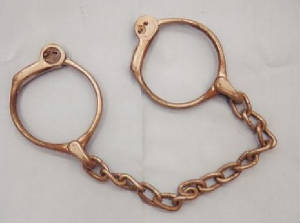
Shackles
Espantoon / Nightstick
Carl Hagen 1960's
Courtesy Kenny Driscoll
1960's Model Carl Hagen Espantoon / Nightstick
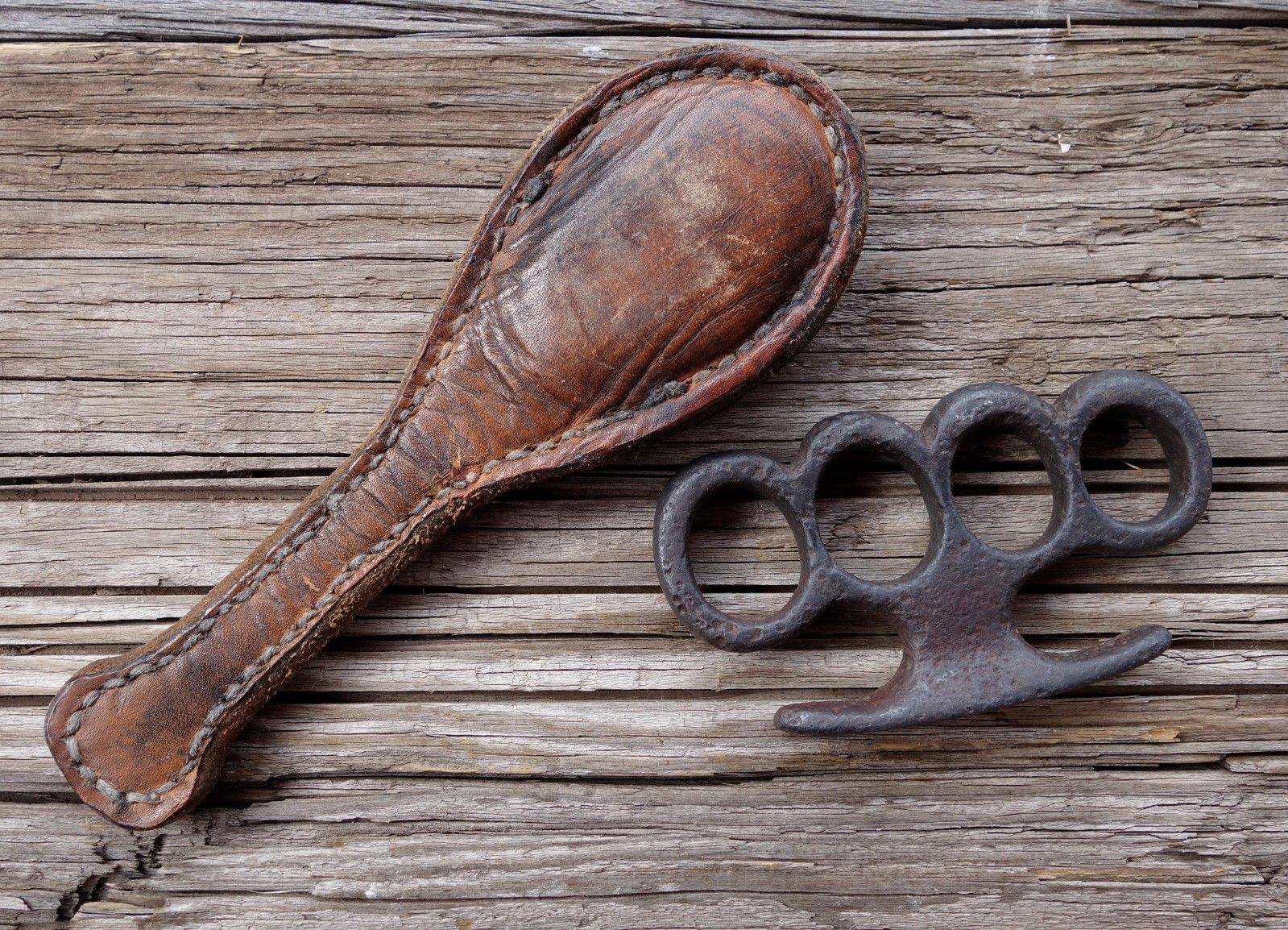
![]()

Before firearms were issued by police agencies - It was not uncommon to see officers carrying
single shot pocket pistols similar to those pictured above.
Possibly the First Line-of-Duty Shooting with issued Firearms
1857 – Possibly the First Police-Involved Shooting with issued firearms. The officers involved were, Deputy Marshall Manly, and Officers G.H.E., Bailey, Nicholson, Saville, Lee, George Bailey, Andrew, Presto, Chapman, and Englar. Shot was Deputy Marshall Manly, suspect Andrew Hesslinger was killed, and an African American named Ramsey was shot. The shooting took place at a bar called Seager’s Lager Beer Brewery at 7 o’clock on that Sunday, the establishment situated upon the Frederick Road at its intersection with West Pratt Street.
Jan 5, 1858, Baltimore Sun reported the following:
Police Officer Shot – 22 December 1857 Southern District Patrolman John Winkleman, was accidentally shot in his thigh a few evenings back when his revolver exploded in his pocket as a result of an incident in which Patrolman Winkleman was twirling his bludgeon [Espantoon] around between his fingers, [when accidently] the stick struck the hammer of his weapon causing it to discharge its load into his thigh. A police surgeon removed the ball.
Taking into account the information value of the word "Ball" when telling us the doctor removed the projectile; "Ball," not "Bullet" is telling. But we'll focus on two other interesting points of this December 22nd, 1857 shooting.
First, this incident occurred at a time just before firearms were issued to Baltimore police officers. It was on the 11th of December, 1856 that Baltimore’s City Council voted on, and passed a bill to arm all Baltimore Police Officers. By October 11th of the following year, not only would the guns be issued but we face what could potentially be, and most likely was the first line-of-duty police involved shooting in our agency that would have occurred with an issued firearm. This based on the following: 1857 - 11 October 1857, The officers involved were Deputy Marshall Manly, and Officer G. H.B. Bailey, P/O Nicholson Saville, P/O Lee George Bailey, P/O Andrew Presto Chapman, and Officer Englar. Shot was Deputy Marshall Manly, Suspects shot and killed were Andrew Hesslinger, and an African American known only as Ramsey. The shootings took place at a bar called, “Seager’s Lager Beer Brewery” at 7 o’clock on that Sunday, the establishment was situated on Frederick Road at its intersection with West Pratt Street.
It was a time when many line-of-duty injuries and deaths took place This because of firearms safety issues; officers using pocket holsters and the less expensive single shot pistols. It wouldn’t be long after this that the department began issuing firearms to their men. The 2nd noteworthy point here is the description given of the Officer “TWIRLING” his nightstick. This might be the earliest reporting of a Baltimore Police Officer spinning his nightstick.
11 December1856 - The end of the year 1856 City Council votes on, and passes a bill to arm all Baltimore Police Officers - 1857 was a date given by History Channel's "Tales of the Gun" - the "Police Guns" Episode, with an original air date, of April, 2000, in which they reported, "Baltimore as having become the first Department in the nation to issue, and provide each police officer with a firearm." The documentary went on to state The Colt, 1849, Pocket Model, was the weapon of choice, and was 1st issued, and used by the BPD and its Officers. Sometimes information contradicts information and as such, we located two Sun Paper articles; one dated,11 December 1856, entitled "Proceeding of City Council", in which arming the individual City Police Officer was voted into law, then on 25 December 1856 an article titled "The New Police Bill" the bill was released. While none of the actual revolvers would have been provided in 1856, they were approved into law on that 11 December 1856. In most cases when a bill is passed, it can take time to actually obtain the guns, catalog serial numbers, inscribe them, and issue them. Initially, they didn't have training, qualifications etc. The accidental shooting of himself by Officer Winkleman took place in 1857, the shooting of Deputy Marshall Manly took place on 11 October 1857 nearly a year after the gun bill was passed and after the guns having been Purchased on 15 August 1867.
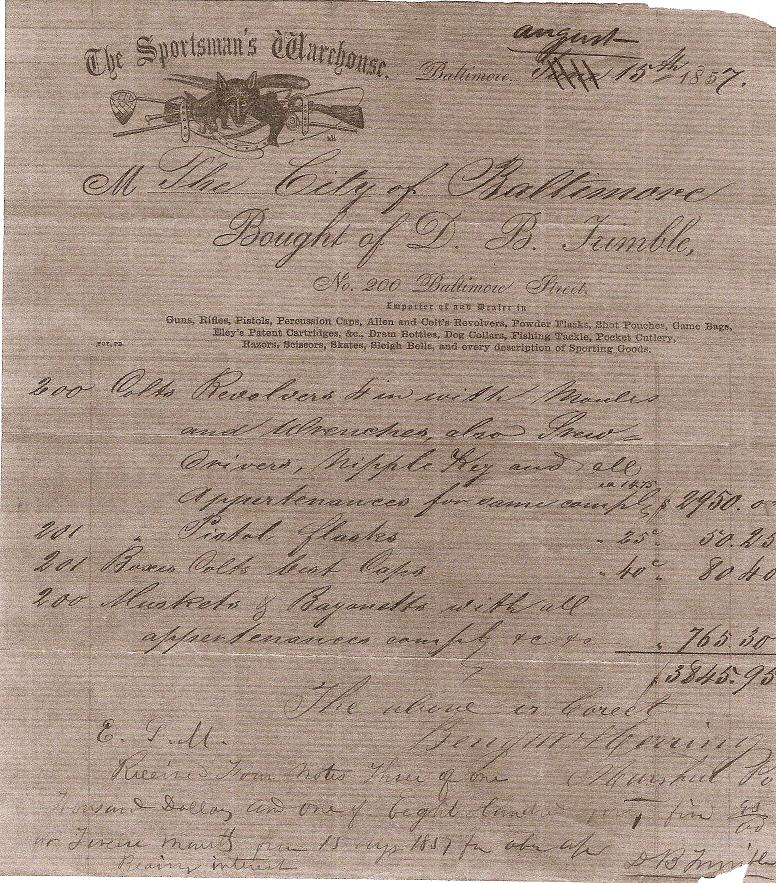
We're only providing the aforementioned information about, "Baltimore being first to arm their police" out of respect for the Discovery Channel, and their source, but I suggest, at least for now, that we take it with a grain of salt. Still, I will leave this until we find definitive proof through further research, or others that have read the previously mentioned article(s) from a Sun Paper, dated 11 December 1856, in which a member of City Council at the time trying to pass his bill to arm Baltimore Police in which he was quoted as saying, "In New York and Philadelphia where there is a penalty for carrying concealed weapons, the police are armed by the city authorities." So if this is his argument for the issuance of like equipment for our police here in Baltimore. This is being taken by us to mean, we wanted what they already have. i.e. we might have been 3rd to have been issued firearms, but by these reports, and the Councilman's argument we were not first.
Speedloader History
Click HERE or on the picture above
![]()
POLICE INFORMATION
Copies of: Your Baltimore Police Department Class Photo, Pictures of our Officers, Vehicles, Equipment, Newspaper Articles relating to our department and or officers, Old Departmental Newsletters, Lookouts, Wanted Posters, and or Brochures. Information on Deceased Officers and anything that may help Preserve the History and Proud Traditions of this agency. Please contact Retired Detective Kenny Driscoll.

NOTICE
How to Dispose of Old Police Items
Please contact Det. Ret. Kenny Driscoll if you have any pictures of you or your family members and wish them remembered here on this tribute site to Honor the fine men and women who have served with Honor and Distinction at the Baltimore Police Department.
Anyone with information, photographs, memorabilia, or other "Baltimore City Police" items can contact Ret. Det. Kenny Driscoll at
Copyright © 2002 Baltimore City Police History - Ret Det Kenny Driscoll


